
A Power Point Presentation -16 mb
It wasn't until some years after the
bitter fighting along the shores of the Niagara River during the War of 1812,
that Niagara started to come into its own as a tourist attraction.
By the 1820's there were three hotels
catering to the visitors of Niagara Falls. The hotel owners were responsible for
the first stunt over the Falls in order to attract attention of members of the
public and to boost the tourist trade.
The hotel owners acquired a condemned
Lake Erie schooner named the "Michigan". The hotel owners then advertised in
advance that they would send the schooner over the Horseshoe Falls on September
8th 1827.
Most of the animals placed aboard were
able to safely escape before the ship broke apart on the shoals and was
swept over the Horseshoe Falls.
This daredevil event took place as
advertised before an estimated crowd of 10,000 people.
This heralded the beginning of 170
years of recorded history of men and women challenging the Niagara River and the
Falls in face of death for fame and fortune. Like a giant roulette wheel, they
came willingly and gambled with their very lives.
SOME
SURVIVED......and......SOME DIED
The river is
ferocious and unforgiving
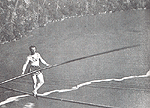
Blondin
balancing between life and death
courtesy of the Niagara Falls (Ontario) Public Library
for a quick reference visit
and then learn all about those
Daredevils listed in the index below
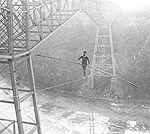
Samuel Dixon
crossing the Niagara River Gorge on a rope in 1890
courtesy of the Niagara Falls (Ontario) Public Library
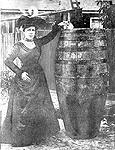
Annie Taylor,
the first to conquer the Horseshoe Falls
proudly displaying her barrel
courtesy of the Niagara Falls (Ontario) Public Library
CHRONOLOGICAL INDEX
Schooner Michigan
Sam Patch
E. Jackson
Blondin the Great
Seth Ford
The Great Farini
William Leonard
Hunt
Captain Joel Robinson
Harry Leslie
Andrew Jenkins
Henry Bellini
Captain J.D. Rhodes
Stephen Peer
Maria Spelterini
David McDowell
Frank Brown
Clifford Calverly
D.H. MacDonald
Charles Cromwell
Walter Campbell
Samuel Dixon
James E. Hardy
Oliver Hilton
Captain Matthew Webb
Carlisle Graham
George Potts
William Hazlett
James Scott
William Kendall
Lawrence Donovan
Alphonse King
Charles Percy
Robert Flack
I.H. Ashley
Peter "Bowser" Nissen
Captain Billy Johnson
Joe Chambers
Martha Wagenfurher
Maud Willard
Annie Edson Taylor
Claus Larsen
Lincoln Beachy
Bobby Leach
Oscar Williams
Peter Langaard
Vincent Taylor
Jean Lussier
Charles Stephens
George L.
Strathakis
William "Red"
Hill Sr.
William "Red" Hill Jr.
Major Lloyd Hill
Ted Mercier
Joseph Hawryluk
Scott Graham
Claus Kirkoff
Roger Woodward
Nathan T. Boya
William A. Fitzgerald
Raymond Weaver
Karl Koch
Bruce Curtis
Ronald Hess
John Kazian
Niagara White Water
Henri Julien Rechatin
Edward Friedland
Jim Sarten
Niagara Gorge River Trips
Mr. X (James Randi)
Kenneth Lagergren
Chris Spelius
Don Wheedon
Carrie Ashton
Karel Soucek
Steven Trotter
Phillipe Petit
John David Munday
Peter DeBernardi
Jeffrey Petkovich
Jessie W. Sharp
Robert Overacker
Kirk Jones
Mr.
Y
Mr. Z
Nik Wallenda
Erendira Wallenda
SCHOONER "MICHIGAN"
1827
(animals aboard)
In 1827, William Forsyth of
the Pavilion Hotel with the help of John Brown of the Ontario House and General
Parkhurst Whitney of the Eagle Hotel in Niagara Falls, New York staged the
very first tourist stunt at Niagara Falls.
Forsyth bought an old
condemned lake schooner named "Michigan"
The "Michigan" was 16 feet from keel to
the deck. The water depth at the crest of the Horseshoe Falls was nearly twenty
feet deep back then (presently 3 - 5 feet).
The hotel owners then advertised in
advance that they would send the schooner over the Horseshoe Falls on September
8th 1827. Printed broadsheets were delivered throughout Western New York and
Upper Canada announcing:
"The pirate Michigan with a cargo of
ferocious wild animals will pass the great rapids and falls of Niagara - 8th
September 1827 at 6 o'clock
The Michigan has long braved the
bellows of Erie, with success, as a merchant vessel: but having been condemned
by her owners unfit to sail long proudly "above"; her present proprietors,
together with several public spirited friends, have appointed her to carry a
cargo of Living Animals of the Forest, which surround the upper lakes, through
the white tossing and deep rolling rapids of Niagara and down its great
precipice, into the basin "below". The greatest exertions are being made to
procure animals of the most ferocious kind, such as Panthers, Wild Cats and
Wolves; but in lieu of these , which it may be impossible to obtain , a few
vicious or worthless dogs, such as may possess strength and activity, and
perhaps a few of the toughest of the lesser animals will be added to, and
compose the cargo...
Should the vessel take her course
through the deepest of the rapids, it is confidently believed that she will
reach the Horse Shoe unbroken; if so she will perform her voyage to the water of
the Gulf beneath which is of great depth and buoyancy, entire, but what her fate
will be the trial will decide. Should the animals be young and hardy and
possessed of great muscular power and joining their fate with that of the
vessel, remain on board until she reaches the water below, there is a great
possibility that many of them will have performed the terrible jaunt, unhurt!"
To further add to the stunt the schooner
was decorated to look like a pirate ship with human shaped dummies tied to her
deck.
The only animals placed on board the
doomed ship included a buffalo, two small bears, two raccoons, a dog and one
goose. Some reports also included two fox, fifteen geese and an eagle. This was
a far cry from the ferocious animals that Forsyth had advertised would be aboard
the doomed vessel.
On September 8th 1827, with a crowd
estimated at 10,000, the ship was towed by Captain James Rough from Black Rock
to Navy Island using the paddle steamer "Chippawa". Here the "Michigan" was
pointed towards the Falls in mid-river. Prior to the release of the "Michigan",
visitors were allowed to board the schooner and view the condemned animals.
At approximately 6 p.m., the schooner
"Michigan" was released into the currents of the upper Niagara River and drifted
towards the Falls. As it reached the rapids, its hull was torn open and the
schooner began filling with water. The two bears running loose on deck jumped
free of the schooner into the rapids. They were able to swim to Goat Island. The
other animals were caged or tied to the ship died when the schooner went over
the Horseshoe Falls. At the base of the Falls, only the goose had survived the
plunge and was caught by Mr. Duggan.
SAM PATCH
1829
(Survived)
On Wednesday October 7th 1829, Sam Patch
became the first daredevil to challenge the Niagara River. The 22 year old from
Rhode island dove into the churning waters of the Niagara River from a height of
85 feet. Mr. Patch chose Goat Island between the Luna Falls and the Bridal Falls
to erect his diving platform. He survived this headfirst high dive unscathed. On
October 17th 1829, Sam Patch made the second successful high dive at the falls
from a height of 130 feet.
Following his feats at Niagara Falls, Sam
Patch went to Rochester where he attempted a 100 foot dive into the Genesee
River. During this dive, Patch died by drowning.
E. JACKSON
1856
(Survived)
On August 27th 1856, E. Jackson swam in
the Niagara River from the Briddle Stairway (Goat Island) to the Horseshoe
Falls.
THE GREAT BLONDIN
AKA:
Jean Francois Gravelot
1859
(Survived)
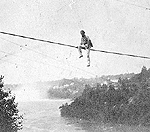
Blondin
crossing the Niagara River Gorge on a rope in 1859
courtesy of the Niagara Falls (Ontario) Public Library
The most famous of Niagara's daredevils
was Jean Francois Gravelot, better know as "The Great Blondin". He was born
February 28th 1824 in St. Omer, Pas de Calais in Northern France.
Blondin first came to Niagara in early
1858. He became obsessed with crossing the Niagara River on a tightrope. On June
30th 1859, Blondin successfully walked across the river on a tight rope. For
this crossing , Blondin utilized a 1,100 foot long - 3 inch diameter manila rope
stretched from what is now Prospect Park in Niagara Falls, New York to what is
now Oakes Garden in Niagara Falls, Ontario. He began his first walk from the
American side and completed his crossing in 20 minutes. Blondin used a thirty
(30) foot (9m) long balancing pole that weighed 40 pounds.
During the summer of 1859, Blondin
completed eight more crossing times. His most difficult crossing occurred on
August 14th when he carried his manager Harry Colcord on his back. During the
summer of 1860, Blondin returned to Niagara for a second successful year of
tight rope walking across the Niagara River for hundreds of thousands of
sightseers. One of his acts included pushing a wheelbarrow along as he crossed.
On September 8th 1860, Blondin completed
his final tight rope crossing of the Niagara River. In 1860, Signor Guillermo
Antonio Farini (aka: William Hunt) of Lockport, New York was Blondin's
formidable rival. Others followed in the absence of Blondin but none was more
daring or famous.
Blondin died in 1897 at the age of 73
years.
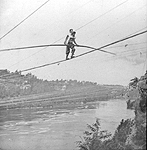
Blondin
tightrope walking across the Niagara River Gorge carrying his manager Harry
Colcord on his back on August 19th 1859
courtesy of the Niagara Falls (Ontario) Public Library
SETH FORD
1859
(Survived)
On July 22nd 1859, Seth Ford swam across
the Niagara River from a location north of the American Falls to the Canadian
shoreline.
SIGNOR GUILLERMO ANTONIO FARINI
"THE GREAT FARINI"
aka: WILLIAM LEONARD
HUNT
1860
(Survived)
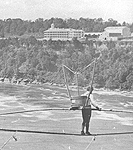
The Great
Farini crossing the Niagara River Gorge on a rope carrying a washing machine on
his back on September 5th 1860
courtesy of the Niagara Falls (Ontario) Public Library
William Leonard Hunt was born Lockport,
New York in 1838. Hunt was raised and educated in Port Hope, Ontario. He had
dual citizenship.
During the early summer of 1860, a young
22 year old Hunt watched intently from the shore of the Niagara Gorge as Blondin
made his way across the Niagara Gorge by walking across a rope strung from side
to side. Hunt turned to his girlfriend and proclaimed that he could do what
Blondin could. That night, Hunt and his girlfriend returned to Lockport, New
York. Hunt was working for the father of his girlfriend as a store keeper, gave
notice to his employer that he was quitting to pursue his career dream as a rope
walker in order to challenge Blondin. His girlfriend immediately broke off their
engagement.
During the summer of 1859, Hunt was
offered $100 to perform at a local fair in Port Hope. Hunt demanded $500 on the
condition that he would stand on his head above the Ganaraska River. Hunt
carried out this performance with a borrowed rope. He walked back and forth
across the river without a balancing pole. In addition, he stood on his head,
did somersaults and walked blind folded as he had promised. Hunt was an
extremely strong young man and had won a tug of war over six other men single
handed.
William Hunt changed his name to Signor
Guillermo Antonio Farini. He would quickly become known as "The Great Farini".
Farini left his home in Port Hope after his father accused him of being a
disgrace to his family by becoming a circus performer.
Farini moved to Minnesota and for a short
time worked at his uncle's general store. Farini then joined the Dan Rice's
floating circus on the Mississippi River. Farini was reunited with his family
after buying his father a farm.
Farini issued a series of challenges to
Blondin but they remained unanswered. Blondin was a more polished acrobat
however Farini was a much more powerful performer and a much better businessman.
Blondin usually took a collection at the end of each performance while Farini
marketed and packaged his performances to ensure a larger audience and financial
success.
Farini's first performance at Niagara
Falls occurred on August 15th 1860. Farini began the tightrope walk while
carrying a balancing pole and an additional coil of rope strapped to his back.
When Farini reached the mid-point he tied the pole to the tightrope and using
the coil of rope he carried with him, Farini lowered himself to the deck of the
Maid of the Mist boat 200 feet below. Getting down was relatively easy. On the
deck of the boat, Farini drank a glass of wine before ascending back to the
tightrope above. This task was much more demanding than Farini anticipated.
Farini was near total exhaustion and nearly fell on several occasions. Farini
did make it back to the tightrope, and continued to the shoreline. After a brief
ten minute rest, Farini made the return crossing blindfolding and wearing
baskets on his feet. This was the first and only time that Farini tried lowering
himself from the tightrope to the river below. Blondin did not try to equal this
feat.
In the weeks that followed, Farini matched
or surpassed each of Blondin's performances. Farini balanced himself on his
head, hung from the tightrope by his toes and carried a person across the
Niagara Gorge on his back. On September 5th 1860, Farini carried an Irish washer
woman across the gorge on his back to counter an earlier performance by Blondin.
When Blondin took out a stove on the tightrope and cooked an omelette, Farini
carried a washtub out on the tightrope. He then lowered a bucket to the river
below to retrieve water in order to wash a dozen handkerchiefs. Farini had a
driving desire to be the best.
Farini performed at Niagara Falls twice
each week. Although his acts were more daring and drew larger crowds, he never
achieved the fame that Blondin did. Blondin received most of the attention and
most of the press.
For Farini, tightrope walking was but one
of his many interests throughout his life. During his life he was an inventor,
an explorer, writer, secret service agent, painter and sculptor. In 1862, while
performing a tightrope walk above a bull ring in Havana, Cuba, a female he was
carrying on his back fell to the ground below. The female dies several days
later.

The Great
Farini hanging from the tightrope over the Niagara River Gorge
courtesy of the Niagara Falls (Ontario) Public Library
On August 8th 1864, Farini returned to
Niagara Falls and attempted to perform another death defying feat. Farini
wearing a pair of specially made stilts waded out into the cascading water just
above the American Falls. Farini planned to walk to the brink of the Falls but
one of the stilts he was wearing was caught in a crevice in the riverbed causing
it to break. Farini suffered a badly injured leg but was still able to reach
Robinson Island which is nearest the Luna Falls. Here he was rescued. Farini
left Niagara Falls defeated and deflated.
In 1866, Farini took his tightrope and
circus act to England, Europe, Africa and the Middle East. During the years that
followed, Farini did many other things with his life. He was an explorer and
during the American Civil War, Farini was a member of the Secret Service for the
Confederate Army, The Great Farini returned to Canada in 1899. He took up the
art of oil painting. He remained active in his later years as well.
William Leonard Hunt, aka: The Great
Farini died in January of 1929 at the age of 91 years. Farini is buried in Port
Hope, Ontario. The Great Farini was one of the worlds greatest tightrope walkers
to ever conquer Niagara.
CAPTAIN JOEL ROBINSON
1861
(Survived)

a stereograph of the Maid of the Mist II
being navigated through the Whirlpool Rapids
by Captain Joel Robinson on June 6th 1861
In 1846, the Niagara Falls Ferry
Association was incorporated. The Maid of the Mist Ferry Service had begun.
The first Maid of the Mist was launched on
May 27th 1846. It remained the only method to cross the border until 1848, when
the first suspension bridge was built. With a ferry service no longer required
the Maid of the Mist boat service realized the need for a tourist boat
attraction.
Due to its popularity, a larger boat, the
Maid of the Mist II was launched for service on July 14th 1854. It was a single
smoke stacked 72 foot long steam propelled paddle wheeler. In 1861, due to a
financial crisis and the impending American Civil War, the Maid of the Mist was
sold at public auction. It was sold to a Canadian Company providing the boat
could be delivered to Lake Ontario. In order to do so the Maid of the Mist would
have to be navigated through the Great Gorge Rapids, the Whirlpool and the Lower
Rapids prior to delivery. The thought was mind boggling and terrifying.
On June 6th 1861, 53 year old Captain Joel
Robinson undertook this mission along with two deck hands. At approximately 3
p.m., with his mechanic, James McIntyre at his side in the wheel house, Captain
Robinson began this perilous journey. His engineer, James Jones was tending to
the boiler to ensure maximum power was available when needed. A short blast of
the boats whistle announced the beginning. With both shores lined with people
who had come to see this spectacle, Captain Robinson and crew rode the Maid of
the Mist through one of the world's most wild and dangerous white water rapids.
The first giant wave, threw Robinson and
McIntyre to the floor of the wheel house and tore the smoke stack from the boat.
Engineer Jones was thrown to the floor of the engine room. On his knees, he held
on to a pipe stand for his life. The boat was now at the mercy of the
mountainous waves crashing against and over the tiny boat. The boat was carried
at approximately 39 miles per hour through the rock strewn rapids. Soon the Maid
of the Mist was propelled into the Whirlpool. The relative tranquility of the
Whirlpool allowed Captain Robinson to regain control of his boat.
Captain Robinson had great difficulty
breaking the Maid of the Mist from the grip of the Whirlpool before challenging
the final leg of this dangerous trip through the dreaded Devil's Hole Rapids. As
the boat escaped the grips of the Whirlpool, Captain Robinson did the best he
could to hold a course through the center of the channel with his badly damaged
vessel.
The three mile journey through the rapids
and the whirlpool was successful except for losing the smoke stack. Captain
Robinson had accomplished something no one had done before and thought
impossible. Captain Robinson and his crew were motivated by the five hundred
dollar reward if they successfully delivered the boat to the docks at Queenston,
Ontario.
The frightening experience of this journey
caused Captain Robinson to give up a career that he loved. He retired into near
seclusion. Captain Robinson died two years later at the age of 55 years.
HARRY LESLIE
1865
(Survived)
On June 15th 1865, Harry Leslie, "the
American Blondin", walked a tightrope across the Niagara Gorge over the
Whirlpool Rapids.
ANDREW "PROFESSOR" JENKINS
aka:
The CANADIAN BLONDIN
1869
(Survived)
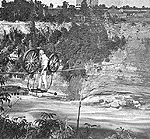
Professor
Jenkins crossing the Niagara River Gorge on his velocipede
courtesy of the Niagara Falls (Ontario) Public Library
Andrew Jenkins
was born in Gloucester England on May 3, 1844 to his parents Mr.
& Mrs. Benjamin Jenkins. He had two brothers William and Adam
and two sisters. His brothers and sister Mary Anne was born in
England. His second sister Elizabeth was born in the United
States following the families move to North America in 1850.The
family settled in the United States where Benjamin Jenkins was a
rail road contractor.
Following his career, Benjamin and his family moved to Canada
and settled in Turnbull Corners which is now Branchton located
near Galt Ontario.
At the age of 15 Andrew Jenkins was taken to Niagara Falls by
his father to see the famous Blondin perform his stunt of
walking across the Niagara Gorge on a tight rope. Since then
Andrew wanted to be a daredevil like Blondin.
Jenkins began practising by stringing a rope between two trees
in his backyard and practiced rope walking on the rope.
Everything that the Great Blondin did, Andrew practiced.
Andrew’s first appearance was performed at a high school picnic
on a rope 50 feet above the ground. He performed high rope walks
locally.
At an early age Andrew saw a bicycle act on a Galt stage. This
is where the idea of riding a bicycle across the Niagara River
gorge on a rope came from.
Andrew Jenkins, also called "the Professor" performed his stunt
Niagara Falls on August 26th 1869.
The “Canadian Blondin" crossed the Niagara River gorge on a 4
inch diameter rope measuring 1040 feet long on a bicycle named
the "doon bike". He was 25 years of age at the time. George
Sleeman, a Guelph Brewer accompanied Andrew to Niagara to help
erect the rope.
He never returned to Niagara Falls to attempt any other stunts.
For 14 years after Andrew Jenkins performed his stunt Niagara
Falls he repeated his performances at different locations across
Canada and United States. He spent a great deal of time
performing daily at Rocky River Resort near Cleveland Ohio on
1000 feet of rope.
After retiring he opened a photography shop in Dunnville,
Ontario and Galt, Ontario.
Andrew Jenkins was nearly blinded when a bottle of ammonia
exploded while he was working in Dunnville. He retained partial
vision in only one eye.
Andrew Jenkins died on July 14, 1924 at the age of 80 years.
- The
information above was provided by Sara and Don Jenkins
The Velocipede Ride across Niagara
How Professor Jenkins crossed Niagara River on a
"velocipede"-what the machine was-how was the event was regarded
August 27, 1869
from the Buffalo Express
On August 26th 1869, a new candidate has made his appearance
before the public for glory, renown and shekels. He is called
"Professor Jenkins", or "the Canadian Blondin", and his forte is
riding the bicycle on a rope. His first call for public
attention in this section of the country was made in a little
handbill announcing that his "performance on the tight rope had
astonished the world, and left competitors far behind", and
furthermore that he would ride a velocipede across Niagara Falls
yesterday afternoon.
Early in the day the crowd around the falls was far from small,
and by noon the excursion trains on the Great Western and Lake
Huron Railroads had brought thousands of people, all anxious to
see the man ride over the falls in the velocipede. But the show
was not at the falls at all, but below suspension bridge, on the
exact spot where the genuine Blondin years ago cross the river
with the man on his back. The rope, 2 inches in diameter and
1000 feet long, was placed in position last Friday, and made as
secure and tight as possible.
The Velocipede and the Rope
The machine used by Professor Jenkins is not in any sense a
velocipede. It is, however, a bicycle, and turned upside down
would resemble in some degree a modern velocipede. The wheels, 3
inches wide are made heavy wood without tires, but in their
places are grooves one and three-quarter inches deep. The front
wheel is 3'2" and the hind wheel two feet - 10 inches in
diameter. The connecting rods are iron, so also the
balance-pole, which is 8 feet long and tipped with 10 pound
balls, and weighs 28 pounds. The whole thing, with the man
thrown in, weighs 298 pounds.
The propelling power is a pinion cog-wheel made of brass, about
9 inches in diameter, which is made to gear to cogs which
surround the front wheel at the bottom of the groove.
It was supposed, naturally enough, that a man writing across the
Niagara River on a single rope would draw a large crowd of
people to the falls; but it costs money to buy ropes and build
fences; and those interested solicited subscriptions to defray
expenses. The amount raised on both sides of the river was $130
of which the Elgin House gave $50. It was also agreed that half
of the receipts at the bridge should go to the performer. The
expenses were about $1000, the rope alone costing $350.
The 1000 feet of good 2 inch hemp rope stretched across the
chasm, 200 feet above the boiling flood, was the first object to
be gazed upon by the crowd, but you could not reach it without
paying $.25 which a great many did, and were rewarded by a close
inspection. The cable was fastened securely and immovably on the
American shore, but on the Canadian shore coiled around a
windlass to facilitate tightening, and then twisted and tied
around a couple of cedar stumps. The deflection of the rope was
about 30 feet. Photographers were early on the ground and
secured the best locations for their cameras.
How It Was Done
At 2:30 o'clock the Professor made his appearance at a small
house on the Canada side with the pieces of his machine, and at
once proceeded to put them together, a task of no small labour.
With the aid of his men, he first placed the fore wheel on the
rope just at the edge of the precipice, and while one man
balanced it, another placed on the standard from the underside,
thus bringing two strong bars of iron on either side of the
rope. All the joints were securely fastened with bolts. The
braces or connecting rods extending from the standard to the
rear shaft in the form of the letter "O" made the connection
complete and very strong. The Professor then got outside of the
rope, arranged the pinion wheel and fastened the balance pole
across the "O" part of the braces. This done, the seat, a strip
of leather, was secured to the rear axle by means of straps.
This arrangement, which it was seen at once would throw the
entire weight of the machine and the rider under the rope was a
source of disappointment, if not of relief, too many of the
spectators, who, not consulting the innovative genius of the
Canadian Blondin, rather expected to see him mounted on a
Greenwood velocipede which of course would give a good chance
for ground and lofty tumbling.
Murmurs
All being in readiness, the bicycle was fastened by a rope to
the bank, and Jenkins who had superintended all the operations
started for his hotel to robe.
During his absence the crowd viewed the machine critically, and
murmurs of "humbug" "sold" "who couldn't" were heard, but as a
general thing the crowd were pleased with the ingenious method
in which the great danger supposed to be involved in the
undertaking had been avoided. By this time the people who had
been pouring in on excursion trains from all parts of Canada had
assembled in convenient locations for observation, to the number
of perhaps 8,000.
The lion made his second appearance at 3:30 o'clock, dressed for
the performance. He wore white tights, black velvet knee
breeches, shoulder straps and cross belts of the same material,
and on his head was placed a crown shaped hat and all were
profusely bedecked with tinsel and beads. His feet were covered
with buff moccasins. Before alighting from the carriage, Jenkins
stopped and talked with our reporter; but there was a little
nervousness apparent about his eyes and mouth which perhaps was
caused by over smoking, or the enormous quid of tobacco he was
seen to bite from a borrowed plug.
False Start
We gave him a word of encouragement, and he at once took his
position astride the rope and proceeded to arrange the leather
strap or seat, which as it was allowed to touch the rope seemed
more for the purpose of protecting the velvet pants from damage
by attrition then to sit upon. In fact he did not set but stood
up with his feet about 18 inches apart, resting on the balance
pole. In a moment he grasped the handles of the pinion wheel and
turned them, moving slowly from the bank, the crowd preserving a
death like stillness. After passing out a few yards a halt was
made, and the photographers were allowed to take his picture. He
then returned and waited five or 10 minutes and resumed his
seat. Three pistol shots were then fired from the Canadian side
and it was a "Go".
The machine move slowly forward, the rope swaying gently from
side to side until he had passed about 50 feet, when another
opportunity was given the artist, after which he crawled along
at a snail's pace to the middle of the abyss, where he raised
and waved his hat and received a faint cheer in response. From
the center to the American shore it was evidently hard work to
propel the bicycle, but at last the edge of the cliff was
reached, and then the welcome did ring with the applause of the
people. The time occupied in passing over the rope was just 11
minutes.
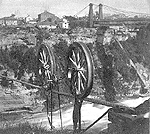
Professor
Jenkins' velocipede
courtesy of the Niagara Falls (Ontario) Public Library
HENRY BELLINI
1873
(Survived)
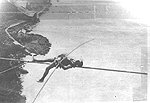
Henry Bellini
tight laying down while rope walking across the Niagara River in 1873
courtesy of the Niagara Falls (Ontario) Public Library
Henry Bellini was born in England.
In 1873, Bellini came to Niagara Falls at
the age of 32 years. On August 25th 1873, Bellini made his first tight rope walk
across the Niagara River using a 1,500 foot long - 2.5 inch diameter rope
weighing 2,500 pounds. He combined a tight rope walk with a leap into the
churning river below. He tried crossing using a 48 pound - 22 foot long balance
pole. Following his leap into the water, Bellini was picked up by an awaiting
boat. Bellini made three such leaps during 1873. In the winter of 1886, Bellini
jumped from the Upper Suspension Bridge. He was hauled from the water
unconscious with broken ribs but alive.
Bellini died in 1888 while jumping from a
bridge in London, England.
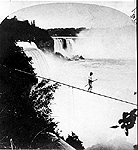
Henry Bellini
tight rope walking across the Niagara River in 1873
courtesy of the Niagara Falls (Ontario) Public Library
CAPTAIN J. D. RHODES
1878
(Survived)
On June 26th 1878, Captain J. D. Rhodes
jumped into the Niagara River from a ninety foot high platform erected below
Prospect Point on the American shore.
STEPHEN PEER
1887
(Died)
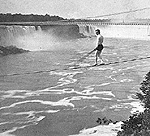
Stephen Peer
in 1887
courtesy of the Niagara Falls (Ontario) Public Library
Stephen Peer was born in 1840 in the
Stamford Township and was 19 years old when Blondin performed his first tight
rope walk in Niagara Falls. Peer wanted to become Niagara's first tight rope
walker.
In 1873, Stephen Peer signed on to become
an assistant to Henry Bellini by helping Bellini string the rope across the
gorge. Peer's first public appearance opened with Bellini's equipment but
without Bellini's consent. Bellini tried to stop Peer by trying to cut the tight
rope without success. Bellini was chased out of town.
By 1887, Peer had become famous enough to
begin performing under his own billing. On June 22nd 1887, Peer performed a
tight rope walk on a five-eighth inch diameter wire cable stretched between the
present Whirlpool Bridge and the Penn Central Bridge. Peer started his crossing
on the Canadian side, successfully completing a double crossing.
On June 25th 1887, Stephen Peer was found
dead laying on the bank of the Niagara river directly below his wire cable. It
is speculated that Peer tried an unscheduled night crossing after an evening of
drinking.
MARIA SPELTERINI
1876
(Survived)
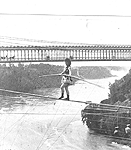
Maria
Spelterini crossing the Niagara River Gorge on a rope in 1876.
The only woman tightrope walker to ever challenge the gorge
courtesy of the Niagara Falls (Ontario) Public Library
Signorina Maria Spelterini became the
first woman to ever cross the Niagara River gorge on a tight rope.
Spelterini was a 23 year old buxom 150
pound beautiful woman of Italian descent. She made her debut on July 8th 1876
performing a successful crossing using two and a quarter inch wire located just
North of the lower suspension bridge ( presently the Whirlpool Bridge). Maria
Spelterini soon proved herself equal to those tight rope walkers that preceded
her.
On July 12th 1876, Spelterini crossed
wearing peach baskets strapped to her feet. On July 19th 1876, she crossed blind
folded. On July 22nd 1876, Spelterini crossed with her ankles and wrists
manacled.
On July 26th 1876, Maria Spelterini made a
farewell crossing. She never performed any more in Niagara Falls. Her personal
life remains a mystery. The date and place of her death are unknown.
July 1, 1876
A Lady to Cross the River on a Single Rope
The great sensation of the present day in the amusement world is
the projected trip across Niagara River of a young lady, lately
arrived from Europe, and known as the Signorina Maria Spelterini.
This young artiste arrived in New York about two months ago, and
has since been quietly making preparations to accomplish the
feat that gave Blondin a world wide reputation.
During her stay in the city the Spelterini gave two
representations at Jones' Wood, and perform feats on the high
rope 100 feet above the ground that at once convinced the
spectators of her perfect right to cucomiums, she has received
from the European press.
Some well-known managers who were present at her initial
performance freely express the opinion that she excelled in
grace and daring any artiste that has ever visited this country.
A Herald reporter paid Miss Spelterini a visit yesterday
afternoon, and in the course of a conversation learned the
following facts:
She was born Livorno, Italy and made her first appearance in
public with her father's company when she was three years of
age. She performed until she reached the age of 10 upon the
tight rope and then commenced the slack-wire and the rolling
globe. In the two last acts, she achieved a brilliant success,
performing for two years in Berlin and Vienna.
In 1871, she went to Russia had made such a great success upon
the high rope that she adopted that branch of her profession
entirely and gave it her sole attention. She is gifted with
wonderful nerve, combined with cool daring, and during her
entire career, she never made a single mistake, although on
several occasions, she was only saved from accident by great
presence of mind.
In 1873, when performing in Surrey Gardens, London, on the day
the Alexandria Palace was destroyed by fire, she was standing on
a platform waiting to commence her act when the rope broke. The
shock threw down the pole on the other end. The one supporting
the platform on which she stood rocked violently as her
assistant was jumping about and about to throw himself off, but
she caught him by the hair of his head and made him stand still
until assistance was brought, and they both landed on terra
firma safe and sound.
On one occasion, when performing at night in Jersey at the
height of 125 feet over the Bay, a violent thunderstorm arose,
frightening everybody in the vicinity, but she went through her
performance with the lightning flashing all around her and never
for a moment lost her presence of mind. Last year, at Oporto
Portugal, she was advertised to carry a boy across on her back,
a distance of 200 feet, about 80 feet from the ground. The boy
disappointed her, and she carried her brother across, a
gentleman weighing 170 pounds.
Speaking of Niagara, the Spelterini does not regard the feet as
anything at all extraordinary, as walking across the river does
not display the artistes nerve half as much as the different
performances that she proposes to give on the rope. If
sufficient strain can be got on the rope so as to stretch it
tolerably straight. She will be able to give her entire
repertoire and, in any case, if the rope can be properly guyed
she will perform some 10 or 12 different acts.
The rope is now being manufactured in the city, and when
completed, will measure 1000 feet and weigh 1,700 pounds. It
will require 1,000 pounds of guys to keep it fairly steady. The
rope will be stretched across the Niagara Rapids about 200 feet
below the Rail Road Suspension Bridge and 800 feet on each bank
of the river will be enclosed and arranged with scats for the
accommodation of spectators. The Erie, New York Central, Great
Western, Canada Southern, and other roads will run trains at
excursion rates to accommodate the visitors anxious to pay a
visit to the falls and see a woman crossed the Rapids on a rope,
a feat never before attempted.
The first performance will be given on July 1, Dominion day at 4
PM and the second at the same hour on July 4, in honour to the
Centennial celebration.
Signorina Spelterini and her brother left last night for the
International Hotel, where she will remain during her stay at
Niagara Falls.
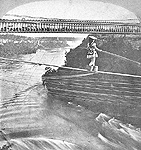
Maria
Spelterini wearing wooden buckets on her feet
crossing the Niagara River Gorge on a rope in 1876
courtesy of the Niagara Falls (Ontario) Public Library
DAVID MCDOWELL
1881
(Survived)
On August 10th 1881, David McDowell of
Batavia, New York walked across the Niagara Gorge on the narrow railing of the
Upper Suspension Bridge. He was intoxicated at the time.
FRANK M. BROWN
1882
(Survived)
On August 25th 1882, Frank M. Brown of New
York City, New York swam across the Niagara River from the foot of the American
Falls to the Canadian shoreline in 4 minutes and 46 seconds.
CLIFFORD CALVERLY
1887, 1890
(Survived)
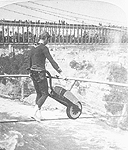
Clifford
Calverly pushing a wheelbarrow across the Niagara River Gorge
on a rope in 1892
courtesy of the Niagara Falls (Ontario) Public Library
Records are very few pertaining to
Clifford Calverly.
Calverly was born in 1870 in
Thornbury, Ontario. He lived in Clarksburg, Ontario where he worked as a
steeplejack. In 1887, Clifford Calverly came to
Niagara Falls to perform his tight rope act.
During his successful crossing he
set a speed record by crossing the gorge in two minutes and thirty-two seconds
as compared to the usual fifteen to twenty minutes required by most of his
predecessors. During subsequent crossings, Calverly skipped rope, hung by one
arm, hung by one foot, sat on a chair and used a wheelbarrow.
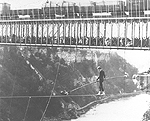
Clifford
Calverly crossing the Niagara River in 1887
courtesy of the Niagara Falls (Ontario) Public Library
D.H. MACDONALD
1887, 1890
(Survived)
D. H. MacDonald made at least one
successful crossing using the equipment of Clifford Calverly.
CHARLES CROMWELL
1887, 1890
(Survived)
Charles Cromwell was born in
Blenheim, Ontario. He was the son of Frank and Maud Cromwell. Frank was an
aerial trapeze artist. Frank and Maud worked for the Ringling Brothers Circus.
Charles grew up and lived in Paris,
Ontario but traveled frequently with his parents and the circus. Once Charles
had grown up he began working with the Yankee Robinson Circus as a rope walker.
A successful tight rope walk across the
Niagara River gorge was completed by Charles Cromwell. Cromwell failed to
attract much media or public attention. Charles completed two crossings of the
Niagara River Gorge. He utilized a 16 foot (4.8m) long
balancing pole that weighed 42 pounds. He died in Galt, Ontario on December 19th 1938 at the
age of 83 years.
WALTER G. CAMPBELL
1889
(Survived)
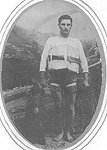
1889
Walter Campbell and dog "Jumbo"
navigated a clinker boat through the Whirlpool Rapids
Walter Campbell was born on October 30th
1868 in Youngstown, New York. He was one of eleven children born to his parents
James and Rachel (Ribble) Campbell.
On September 15th 1888 at approximately
3:20 p.m., nineteen year old Walter Campbell set out along the Niagara River
with several friends and his pet dog "Jumbo" in a small clinker built boat.
Campbell rowed to the old Maid of the Mist
landing (just south of the Michigan Central Railway Cantilever Bridge) where he
dropped his friends off.
Campbell wearing bathing trunks and a cork
life preserver, set out form shore with his pet dog onboard. Campbell was
standing while using an oar as a rudder to guide his boat to the middle of the
river.
Campbell was swept downstream by the
current into the Whirlpool Rapids. As he entered the ferocious white water, his
dog "Jumbo" was thrown into the water ahead of the boat. Campbell lost the oar
he was holding. He crouched down into the boat and was seen holding the sides of
the boat as it pitched wildly in the water.
As the boat was propelled through the
rapids, it quickly filled with water. The boat broke into pieces, throwing
Campbell into the water.
Campbell had to swim against the current
to avoid being struck by the wreckage of the boat, before being swiftly carried
into the Whirlpool. At the Whirlpool, Campbell was able to swim to the Canadian
shoreline where he was rescued twenty minutes after his journey began.
Campbell's pet dog died from drowning
during the perilous journey.
Following his feat of survival, Campbell
earned a thousand dollars for a four week appearance at the old Wonderland in
Buffalo, New York.
On January 16th 1909, died at the age of
39 years, two weeks after he had been committed to the county almshouse as a
result of a chronic illness.
SAMUEL J. DIXON
1890
(Survived)
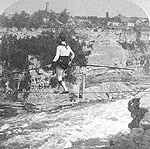
Samuel Dixon
crossing the Niagara River Gorge on a rope in 1891
courtesy of the Niagara Falls (Ontario) Public Library
Samuel J. Dixon was a photographer from
Toronto, Ontario. On September 6th 1890, Dixon crossed the Niagara River gorge
using a seven - eighths inch diameter rope stretched across the gorge over the
wildest part of the Whirlpool Rapids. His balancing pole was made up of three
pieces of gas pipe - sixteen feet in length. Dixon crossed from the Canadian
side to the American side before returning. On the return he added more suspense
by lying on the rope with the pole resting on his chest, standing on one foot
and by hanging from the rope with one hand. Dixon was truly the last of the
memorable tight rope walkers ever to come to Niagara Falls.
JAMES E. HARDY
1896
(Survived)
James E. Hardy came from Toronto, Ontario
to Niagara Falls in the summer of 1896. At the age of 21 years, Hardy was the
youngest person ever to tight rope walk across the Niagara River gorge. During
the summer of 1896, Hardy made sixteen crossings. James Hardy died in May 1939
at age 65 in the City of Toronto.
OLIVER HILTON
1897
(Survived)
Oliver Hilton came to Niagara Falls from
Hamburg, New York. He was a professional circus rope walker. Hilton claims to
have crossed the Niagara River gorge on September 16th 1897 ( at the age of 10
years) in stocking feet on the rope that James E. Hardy had left behind. No
proof existed to support this claim.
CAPTAIN MATTHEW WEBB
1883
(Died)
Captain Matthew Webb was born in
Shropshire, England in 1848. He was one of seven children born to his parents,
Matthew Webb and Sarah Cartwright. At the age of 12 years, Matthew Webb enrolled
as a sea cadet on the naval training ship, the HMS Conway in Liverpool, England.
He became an experienced sailor. During his years at sea, he became a very good
swimmer. He became famous for his swimming feats, many performed while saving
human lives.
In 1873 Webb became the recipient of a
gold medal from the Royal Humane Society of Great Britain for lifesaving for
jumping off a Cunard steamer "Russia" to save a sailor who had been washed over
board.
On August 24th 1875, Webb swam the English
Channel. Webb came to Niagara Falls during the Summer of 1883 to challenge the
Niagara River. He had been promised a $2,000 reward if he swam the Niagara River
Whirlpool Rapids.
At 4 p.m. on the afternoon of July 24th
1883, Captain Webb was rowed out from the Maid of the Mist landing to the middle
of the Niagara River by Jack McCloy. At 4:25 p.m., Captain Webb dove into the
river and began swimming towards the great whirlpool rapids. Eye witnesses claim
that Captain Webb made the trip through the rapids in two minutes only to be
drawn underwater at the vortex of Whirlpool. There are however conflicting eye
witness accounts as to whether Captain Webb drowned in the rapids or in the
whirlpool. At any rate, Webb's mangled body was recovered from the Niagara River
near Queenston four days later History would later prove that the swim Captain
Webb had undertaken could be done successfully.
Captain Webb was buried at Oakwood
Cemetery in Niagara Falls, New York.
On August 22nd 1886, a Boston Policeman
made the trip through the rapids wearing a cork life preserver. On July 18th
1933, William Kondrat age 18 of Chatham, New Jersey began swimming across the
Niagara River near the Maid of the Mist docks. Kondrat was swept down river by
the current towards the Great Whirlpool Rapids. Kondrat survived the rapids and
the Whirlpool by the narrowest margin. Before being rescued Kondrat had been in
the water nearly two and a half hours.
CARLISLE GRAHAM
1886
(Survived)
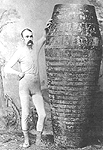
Carlisle
Graham posing with his barrel
courtesy of the Niagara Falls (Ontario) Public Library
On July 11th 1886, Niagara Falls witnessed
its first barrel stunt. Carlisle D. Graham, an English cooper (barrel maker) who
had recently immigrated to Philadelphia Pennsylvania USA came to Niagara Falls.
Graham had constructed a five and a half foot barrel of oaken staves and
handmade iron hoops for his widely advertised trip.
On Sunday July 11th 1886 during the early
afternoon, Graham began his trip from what is now the Whirlpool Bridge through
the great gorge rapids and the whirlpool. Graham stood six feet tall had to
stoop over once inside the barrel to allow the water tight lid to be screwed
into place. He was completely encased in a waterproof canvas sheath with the
exception of his two arms which allowed Graham to hold onto inside mounted metal
handles. The initial trip took 30 minutes. Graham survived but had become
extremely ill and dizzy from the ride.
This led Graham to announce that on August
19th 1886 he would make a second trip. In this trip he would keep his head
outside of the barrel. On August 8th 1886, before Graham could undertake this
stunt, two fellow shipmates George Hazlett and William Potts successfully
conquered this same stretch of river using Grahams barrel. Both survived
uninjured.
Carlisle Graham made his second trip as
scheduled on August 19th 1886. Graham survived but leaving his head outside the
barrel resulted in Graham sustaining hearing impaired. On August 18th 1886, the
day before Graham's second trip, James Scott, of Lewiston, New York attempted to
swim the rapids and lost his life.
In November 1886, George Hazlett and his
girlfriend Sadie Allen of Buffalo, New York rode the barrel together through the
rapids and the whirlpool without incident.
Graham made his third trip through the
rapids on June 15th 1887 and his fourth trip on August 25th 1889 in a newly
designed seven foot long barrel.
Now famous, Graham announced that he would
ride his barrel over the falls but did not carry out his plan. On July 14th
1901, Graham made his fifth trip through the whirlpool rapids. During this trip
he nearly suffocated to death after getting caught in a whirlpool eddy for
twenty minutes.
On September 6th 1901, Graham loaned his
barrel to Martha Wagenfuhrer of Buffalo, New York. Miss Wagenfuhrer became the
first woman to successfully navigate the rapids and whirlpool alone. On
September 7th 1901, Graham arranged a double performance with friend Maude
Willard of Canton, Ohio. Willard would ride the barrel through the rapids to the
Whirlpool and both she and Graham would swim the rest of the way to Lewiston.
Willard rode Graham's barrel through the rapids then was caught in the whirlpool
for several hours before she could be rescued. Willard was found dead of
suffocation. She had taken her pet fox terrier along with her and the dogs nose
had become stuck in the barrels only air hole.
On July 17th 1905, Graham swam a race in
the lower rapids below the Whirlpool to Lewiston with William J. Glover Jr. of
Baltimore Maryland. Glover won the race. Glover was 32 years old and Graham was
45 years old. Both wore life preservers and neck braces. Graham's date of death
is unknown. He is buried in Oakwood Cemetery in Niagara Falls, New York.
GEORGE POTTS
and
WILLIAM HAZLETT
1886
(Survived)
On August 8th 1886, George Potts and
William Hazlett, together, navigated through the Whirlpool Rapids in a barrel
owned by Carlisle Graham.
JAMES SCOTT
1886
(Died)
On August 22nd 1886, Carlisle Graham had
offered $10 to anyone willing to retrieve his barrel from the Whirlpool
following his daredevil stunt ride through the Whirlpool Rapids. James Scott
agreed to Graham's offer. While awaiting Grahams return, Scott made a practice
jump into the water from a location west of Thompson's Point at the Whirlpool.
Scott failed to resurface and died of drowning.
WILLIAM KENDALL
1886
(Survived)
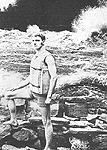
William
Kendall - 1886
courtesy of the Niagara Falls (Ontario) Public Library
On August 22nd 1886, William Kendall went
through the Whirlpool Rapids wearing only a life preserver as protection.
LAWRENCE DONOVAN
1886
(Survived)
On November 7th 1886, Lawrence Donovan
jumped into the Niagara River from the Upper Suspension Bridge while wearing
suit, canvas shoes and a bowler hat.
ALPHONSE "PROFESSOR" KING
1886, 1887
(Survived)
On December 15th 1886, Alphonse
"Professor" King walked 30.5 meters (100 feet) on the Niagara River near the
Canadian shoreline while wearing a pair of tin shoes. King called his shoes
"Golden Fish". This stunt took place at the Upper Suspension Bridge.
On August 14th 1887, Alphonse King crossed
the Niagara River below the Horseshoe Falls on a water bicycle. The modified
bicycle consisted of a wheel with paddles erected between two water tight
cylinders - 8 inches (20 cm) in diameter and 10 feet (3m) long.
CHARLES A. PERCY
1887, 1888
(Survived)
On August 28th 1887, Charles A. Percy
successfully navigated the Whirlpool Rapids in a boat. Percy was unable to
continue his journey along the river to Lewiston New York because his boat
became stranded in the Whirlpool.
On September 16th 1888, Percy again
successfully navigated the Whirlpool Rapids in his boat. On this trip, Percy was
able to cross the Whirlpool and continue his trip through the Great Gorge Rapids
(Devils Hole Rapids) on route to Lewiston. As Percy was passing the Niagara Glen
area, he was tossed out of his boat. Percy was wearing a life preserver and was
able to floated down river the remaining distance to Lewiston, New York.
ROBERT FLACK
1888
(Died)
On July 4th 1888, Robert Flack was drowned
while attempting to navigate the Whirlpool Rapids in a boat. Flack was using a
self described "secret" buoyant filling which turned out to be excelsior (wood
shavings). Flack had secured himself into his boat by a number of harnesses.
Unfortunately Flack's boat over turned and Flack was unable to free himself
before drowning.
I.H. ASHLEY
1890
(Survived)
On May 3rd 1890, I.H. Ashley of Chicago,
lowered himself from the Upper Suspension Bridge into a small boat waiting in
the Niagara River below. Ashley used aluminium tape controlled by a clutch to
lower himself to the awaiting boat.
PETER "BOWSER" NISSEN
1900, 1901
(Survived)
In July 1900, Peter Nissen came to Niagara
Falls to challenge the Niagara River. Nissen had brought with him a specially
built boat in an attempt to conquer the great gorge rapids and the whirlpool.
His boat was twenty feet long with a six foot wide beam and four foot depth. It
was entirely decked over except for a center cockpit. Nissen has air
compartments built into the front, back and sides of the cockpit. Nissen first
trip through the rapids was successful however his boat became trapped in the
Whirlpool for over an hour before being brought to shore. The next day, Nissen
completed the trip from the Whirlpool to Lewiston.
Over the winter, Nissen rebuilt his boat.
It was longer and two feet narrower with an eight horsepower steam engine. It
had a larger rudder and more ballast. After making several successful runs in
the river just below the falls, Nissen was ready to challenge the rapids. On
October 12th 1901, Nissen rode the boat through the rapids. As he did, he ducked
into a crawl space under the cockpit without incident. In a later incident,
Peter Nissen and friend James Rich began to do depth soundings in the Whirlpool.
While doing so the boat was caught in the vortex of the Whirlpool and damaged
severely. Both Nissen and Rich narrowly escaped death but the boat sank.
The first person to actually ride the
rapids in a boat was Charles Percy in August 1887. Percy was riding a seventeen
foot boat. He made three trips through the rapids in 1887. On Percy's last trip
he narrowly escaped death and his boat sank.
On July 4th 1888, Robert Flack of
Syracuse, New York was killed in an attempt to copy the feat of Charles Percy.
Flack had secured himself into his boat by a number of harnesses. Unfortunately
Flack's boat over turned and Flack was unable to free himself before drowning.
CAPTAIN BILLY JOHNSON
1901
(Survived)
On July 4th 1901, Captain Billy Johnson
jumped into the Niagara River from the deck of the Maid of the Mist boat just
below the Horseshoe Falls and swam down river.
JOE CHAMBERS
1901
(Survived)
On August 2nd 1901, Joe Chambers swam the
Lower Rapids (Devils Hole Rapids) between the Whirlpool and Queenston -
Lewiston. Chambers wearing a life buoy arrived safely at the dock in
Lewiston, New York.
MARTHA WAGENFURHER
1901
(Survived)
On September 6th 1901, Martha Wagenfurher
journeyed through the Whirlpool Rapids in a barrel. Upon reaching the Whirlpool,
Wagenfurher became stranded in the middle for such a lengthy period of time that
it became necessary to call for the Great Gorge Railway illumination car to be
brought to the Whirlpool so its search light could illuminate the water surface.
When Wagenfurher was pulled to shore she was exhausted and sea sick but
otherwise uninjured.
MAUD WILLARD
1901
(Died)
On September 7th 1901, Maude Willard and
Carlisle Graham planned a combined stunt. Willard would traverse the Whirlpool
Rapids in Graham's barrel and from the Whirlpool she would continue to Lewiston
with Graham swimming behind the barrel.
Willard entered the barrel with her pet
dog for the journey through the rapids. As the barrel reached the Whirlpool it
became stranding for the next six hours in the middle.
When the barrel was recovered and brought
to shore, Maude Willard was dead. Her pet dog jumped out of the barrel
uninjured. The dog survived the ordeal by putting its nose to the only air hole
the barrel had allowing the dog to breathe which resulted in Willard suffocating
to death.
ANNIE EDSON TAYLOR
1901
(Survived)
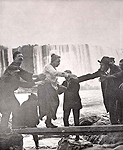
An historical
picture of Annie Edson Taylor being rescued following her plunge over the
Horseshoe Falls
courtesy of John Guthrie
On Monday October
21st 1901, Mrs. Annie Edson Taylor shot the Horseshoe Falls this
afternoon and survived, a feat, never before accomplished, and,
indeed, never attempted except in the deliberate commission of
suicide.
Not only did she survive, but she escaped without a broken bone,
her only apparent injuries being a slight scalp wound, a
moderate concussion, some shock for her nervous system and
bruises about the body.
She was conscious when taken out of the barrel. The doctors in
attendance upon her tonight said that although she was somewhat
hysterical, her condition is not at all serious, and that she
probably will be out of bed within a few days.
The initial voyage over Niagara's cataract began at Port Day,
nearly a mile from the brink of the falls. From Port Day, Mrs.
Taylor and her barrel were taken out to Grass Island, where she
entered the barrel, and at 3:50 p.m. she was in tow of a boat
speeding well out into the Canadian current. At 4:05 p.m. the
barrel was set adrift and Mrs. Taylor was at the mercy of
currents in the water that never before have been known to spare
a human life once in its grasp. From the spot where the rowboat
left the barrel the current runs frightfully swift and soon
breaks over the reefs that cause the water to toss in fury. The
barrel was weighted with a 200 pound anvil and it floated nicely
in the water. Mrs. Taylor apparently retained in an upright
position for the greater part of the trip down the River and
through the rapids.
Fortunately the barrel was in deep water, and except for passing
out of sight several times in the white crested waves, it was in
view for the greater part of a mile. In passing over the
horseshoe fall the barrel kept toward the Canadian side 300 feet
from the center. It dropped over the fall at 4:23 p.m. the
bottom of the barrel leading the way. In less than a minute it
appeared at the base of the fall and was swept downstream. The
current cast it aside in an eddy where it floated back upstream
and held between two eddies until captured at 4:40 p.m.
At 2:30 p.m. this afternoon a boat containing Mrs. Taylor, her
barrel, Fred Truesdale and William Holleran, pulled out from
Port Day, and went to Grass Island.
Just before the boat was pushed off, Mrs. Taylor turned to a
Cataract Journal representative and hand him an empty envelope
on which was written the address "Mrs. Jane M. Kendall, Eddytown,
New York." Mrs. Taylor had written this address just before she
left the house to enter the boat and the strong firm hand in
which he wrote testified to her coolness and calmness. "This is
my sister" said Mrs. Taylor "and in case of accident and I
should not come back, will you kindly notify her?"
Mrs. Taylor changed her clothing and entered the barrel there,
and at 3:30 p.m., Truesdale and Holleran with the barrel in tow
started out into the river. They pulled within 200 yards of the
Canadian shore right where the water is good and deep, and there
at 4 p.m. said "goodbye" to Mrs. Taylor and the barrel. The
current caught the strange craft immediately, and it was swept
rapidly toward the tossing waters of the upper rapids.
Truesdale and Holleran rolled the barrel into shallow water at
the head of Grass Island. Water was found to be trickling
through one of the barrels seems. Truesdale caulked the crevice
while Annie lamented the time lost, yearning to get underway.
Soaked in water the wooden staves expanded, cutting off the
seepage. The men dragged the barrel ashore like before. She did
not want to particularly disrobe in front of everyone, nor be
seen squeezing her body through the barrels narrow hatch.
Graciously the river men, reporters and cameramen retired to the
far side of the island. Screened from being viewed by reeds, she
peeled off her hat, jacket, and outer skirt and placed them in
the boat. Wearing a blue and white shirtwaist opened at the
throat, she squirmed into her barrel. Modesty saved, she gave
the all clear and the men came back.
She fastened herself into Captain Johnson's harness. Two big
cushions were passed in and position for maximum padding. She
held a pillow to place on top of her head once the barrels lid
was battened down. Facing her as she reclined were the three
small air holes in a vertical row. Two were plugged with corks
which she could remove if she needed more air. Through a rubber
hose screwed into the top hole from inside, the bicycle pump
would fill the barrel with air. She would then cork the spout of
the hose, and if for air supply became exhausted she could
uncork the hose and continue breathing - snorkel fashion.
"Now you may go ahead with the pump" she called out, her voice
sounding faint inside the barrel. Holleran eagerly grabbed the
bicycle pump and connected it to the barrels valve and began
pumping air into the barrel. He pumped for several minutes until
the pump began to labour. Panting and puffing, he hollered to
Annie, "Have you got enough air?" Taylor replied she had.
When released, the barrel floated at an angle of 45°, but
everybody was afraid that an anvil fastened to the bottom would
cause it to stick on the rocky ledges.
Nothing like this occurred, however and onward went the barrel.
Thousands of spectators watched its progress from every
available point, none sure that the woman was in the barrel. The
barrel hung well in the Canadian channel. Once or twice a
disappeared in the boiling water at the foot of the reefs, but
each time it emerged and was carried onward by the current. It
rode the waves magnificently.
At 4:23 p.m. every spectator watched breathlessly as the barrel
made the plunge over the crest of the Horseshoe Falls passing
over about 200 feet toward the Canadian side from the center.
The fall was 158 feet.
One minute later the barrel was seen floating in the foaming
waters at the foot of the fall. Cheer upon cheer went out by the
spectators.
The barrel was all right. Was the woman in it? If so, was she
alive?
It swept close to shore between two eddies. At 4:30 p.m., it was
captured and pulled out on a rock. When the cover was broken
off, Mrs. Taylor raised her arm and waved her hand. The small
group of rescuers cheered and the people on the cliffs knew that
she was alive and responded with cheers. It was necessary to saw
a portion of the top away to get her out. She walked across a
plank to the shore and was seen on her way to her boarding house
in the Niagara Falls, New York.
The barrel was half filled with water and she had a cut 3 inches
long back of her right ear. Her shoulders are strained and she
suffered severely from shock.
As the doctors worked over her she said to a correspondent:
"I felt as though I was being knocked pieces in churned all
over; that all nature was being annihilated. I thought of trying
not to break my neck. I caught on to the side straps. After the
men sent me a drift I closed my eyes and prayed God to spare my
life. I struck rocks three times and the water seemed to come in
the barrel everywhere. I knew when I went over the fall, and
lost my senses just a minute. I am not a sporting woman. I have
always lived a good life, and am not afraid to face God or man
if it was with my dying breath I would warn anybody not to do
it. I felt like I was all alone. People here have been good to
me and I did this to help those who helped me. I hope some good
will come of it. I would rather face a cannon knowing that I
would be blown to pieces, then go over the falls again. I feel
that I want to offer a prayer to God for sparing my life".
Mrs. Taylor declared that her idea of going over the falls grew
old of reading of Captain Webb's feat of undertaking to swim the
rapids. Yesterday she admitted that "financial results" was what
she was after.
"I do not wish to be classed with women who are seeking
notoriety" said Mrs. Taylor, "I am not going over the falls as a
mere act of bravado. I feel that something may accrue from it in
a financial way". "I first made a barrel of paper in my room in
my boarding house in Bay City, prepared myself as if for a trip
and got into it. Thus I got my idea as to the proper size of the
barrel, then I drew a diagram of it, marked the dimensions and
had a copper make it".
"At first I preserved the utmost secrecy about it, not even
letting my fellow boarders know of it. But after I got a
manager, I learned that I could make nothing of the venture
without notoriety. When the newspapers learned of it, I was
hounded almost to death by reporters. One of them went so far as
to ask me "do you seriously contemplate committing suicide?" I
retorted "I hope I do not look like a person who would do that.
Why only this morning when I called Mayor Butler to get a permit
to sell pictures of myself and barrel, he asked me "are you the
fool that's going over the falls?"
As it was landed on a rock out in the river it was difficult to
handle but several men soon had the lid off. Mrs. Taylor was
alive and conscious but before she could be taken out of the
barrel it was necessary to saw a portion of the top away. Her
condition was a surprise to all. She walked along the shore to a
boat and was taken down the river to the Maid of the Mist dock
where she entered a carriage and was brought to Niagara Falls,
New York.
She is suffering greatly from the shock. She had a 3 inch cut in
her scalp back of her right ear, but how or when she got it she
does not know. She complains of pain between the shoulders, but
this is thought to be from the fact that her shoulders were
thrown back during the plunge, as she had her arms in straps,
and these undoubtedly saved her neck from breaking.
In passing over the falls she admits having lost consciousness.
While thanking God for sparing her life, she warns everybody
against trying to make the trip. So severe was the shock that
she wanders in her talk but there is little doubt that she will
be in good condition within a day or two.
Three doctors are at her bedside tonight.
The trip was witnessed by several thousand people. The fact that
Mrs. Taylor failed to go on Sunday did not lessen the confidence
of the public in her. Still everybody was agreed that it was a
foolhardy trip.
The Washington Post reported that Minnie Edson Taylor, 50 years
old, went over Niagara Falls on the Canadian side this afternoon
and survived, a feat never before accomplished and indeed never
attempted except in a deliberate commission of suicide. She made
the trip in a barrel.
By her calculations, the anvil fastened to the bottom of the
barrel kept the foot downward, and so it too landed. Had turned
over and landed on its head, Mrs. Taylor's head would have been
crushed in and her neck broken.
During her stay here she has impressed everybody with her
wonderful nerve. Mrs. Taylor is an interesting well-educated
person. She is very much unlike the general run of cranks and
fools who do feats or talk of doing them at the falls. She is
about 43 years old and good-looking. She says she is a teacher
of physical culture and dance schoolteacher and recently came
here from Bay City Michigan. She is a graduate of the New York
University at Albany New York. She talks of aristocratic friends
in Boston, New York, Philadelphia and other large cities.
It was reported that Mrs. Taylor was 43-50 years old at the
time. She was born in Auburn New York and has crossed the
American continent eight times. Genealogical records confirm the
year of Annie’s birth in 1838 however the actual date is subject
to much speculation. Taylor claims her birth date was October
21st, the date of her stunt. The best evidence is that Annie
Edson Taylor was 63 years of age at the time of her successful
stunt. Annie had a propensity to exaggerate the circumstances of
her life and age to augment the hype surrounding her stunt.
Annie Taylor was 5'4" tall and she weighed 160 pounds at the
time of her stunt.
Rescued
Carlisle Graham
waited on the Canadian shore about 50 yards below the falls.
Among the score of others eager to help land the barrel were
Graham's friend "Kid" Brady, a featherweight boxer, Capt. Billy
Johnson, Maid of the Mist engineer John Ross, and Harry
Williams, proprietor of the Lafayette Hotel the Niagara Falls,
Ontario.
The barrel veered into Big Bass eddy. Graham and a handful of
others leaped onto a reef in the pool. The barrel circled the
spume-coated waters several times. Always just beyond the men's
reach. Finally a Niagara Falls, Ontario, man named Mark Mundi
snagged the barrels towline with a grappling hook. Kid Brady
stripped to his swimming suit and slip into the water. Holding
on to the rock he grasped the rope and passed it up to Graham.
Scrambling back up, Brady joined Graham Ross and Williams as
they pulled the heavy barrel out of the water onto the rock.
Quickly they cut the lid off. Ross, on his hands and knees,
poked his head inside. Cradled on a saturated pillow, a sickly
white face turned its eyes upward and blinked in the flood of
daylight.
"She's alive!" cried Ross.
The Test Trip
Taylor had hired a promoter of carnivals, fairs and other
exhibitions named Frank "Tussie" Russell, age 34 of Bay City. He
seemed like a perfect choice to manage a high diving feat. He
was hired by Mrs. Taylor to become her manager and promoter.
Taylor although wanting little recognition learned that there
was little money to be gained without notoriety.
Perhaps one of RusselI`s first jobs was to secure local help to
launch Taylor in her barrel from the Niagara River. Inquiries
led Russell to the Buffalo Avenue home of the brawling teamster
named Fred Truesdale. A strong, wiry man with the black bushy
moustache, Trusedale had fished and hunted ducks on the upper
river for years and knew its occurrence and temperament like a
book. A number of times, at the request of other would be
daredevils, Truesdale rowed across the river and dumped a barrel
overboard in the current that sweeps over the horseshoe's
western rim close to the Canadian shore. It must've been
Truesdale who suggested sending Annie's barrel over the falls on
a trial run first with a cat inside.
Before the big day came, and before the preliminary test drop,
Annie's barrel was removed from the lobby of the state Park
hotel and taken to an alleyway, perhaps behind the hotel, were
Annie posed for pictures inside her barrel. Crudely hands
painted on the staves were the words "Queen of the Mist".
On the afternoon of Friday, October 18th 1901, Russell and
several helpers rolled the barrel into a dray and brought
Annie’s` pet cat named "Iagara" to Port Day. Here the barrel was
loaded into his boat, the cat placed inside, and the manhole
cover closed. The barrel was then towed the near the Canadian
shore and released. The barrel was carried over the Horseshoe
Falls. It was later recovered by Captain Richard F. Carter and a
deckhand took a rowboat upstream where they snag the barrel near
the Canadian shore contorted back to the dock the lid wasn't
screwed and the reportedly jumped out however in reality the cat
was dead. The cause of death is said to have been suffocation.
The barrel was undamaged.
Aborted Attempt
On Sunday October 20th 1901, Mrs. Taylor made ready for her
great adventure. This was the originally scheduled date for her
attempted stunt. The weather was clearly an issue and concern
for Truesdale and the others as high winds prevailed churning
the navigable portion of the river from which they planned to
release Taylor inside her barrel. At 2 p.m., in the company of
her manager Frank M. Russell and representatives of the press,
she arrived at the dock at Port Day. Though it may have caused
her some embarrassment she removed most of her outer clothing
and stood attired only in trunks and a jacket. A few moments
later she slid through the opening in the top of the barrel
which floated in shallow water near the quay. Her barrel was
towed out to the middle of the River however high winds
precluded its release and the journey was cancelled by Truesdale
and she was returned to shore.
Family History
Merrick Edson married Lucretia Waring. Merrick operated a large
flour mill that he owned on the Owasco River in Auburn New York
Anna Edson was the fourth child and second daughter of Merrick
and Lucretia. Anna was born in Cayuga County New York in 1838.
Genealogical records confirm the year of Annie’s birth however
the actual date is subject to much speculation. Mr. and Mrs.
Edson had 11 children: four girls and seven boys.
When Annie was 12 years of age her father died. He was killed in
a tree cutting accident on the farm on March 23rd 1850. Her
mother Lucretia died not long afterwards. At the age of 14 she
and her two older brothers John and Delano were sent by their
guardian to attend the Conference Seminary and Collegiate
Institute in the Village of Charlottesville, New York about 50
miles west of Albany.
During her stay at the seminary she roomed with another student
by the name of Jennie Taylor. They became close friends and
eventually became relatives when Jennie married Annie's brother
Delano and in 1856, following four years of school, Annie
married Jennie's brother David Taylor, a medical student from
Branchport New York. David was 11 to 13 years older than Annie
was at the time of their marriage. They had one child who died
several days following birth.
It is believed that her husband David enlisted in the 19th
infantry in Auburn New York in 1861. He was a first lieutenant
in the Union Army. Taylor was wounded in battle at Weldon
Railroad in Virginia on June 21-23rd 1864 and later died of his
wounds. Although Annie claims to have been widowed at the age of
20 it was more likely that she was widowed in her mid to late
20s.
She decided to become a schoolteacher, one of the few
occupations open to American women in the 1800s. She became a
teacher of physical culture and dance. In 1898, she moved to Bay
City, Michigan from San Antonio, Texas. Work in Michigan was
sparse. Taylor was becoming increasingly lonely, impoverish and
despondent.
Annie Taylor’s Version of Stunt
Mrs. Anna Edson Taylor describes her sensations during the
passage over Niagara Falls in a barrel:
"Then I said to Mr. Truesdale, the boatman, that he could cut me
loose, but when he did so to wrap on the barrel with his ore. A
moment later came the warning rap and I was off, but not before
I cried out to Mr. Truesdale- “there is water coming in here.”
He answered, "There isn't enough to do any harm and you'll be
over in 5 minutes.”
Mr. Truesdale's voice seemed to come from a great distance, to
be swallowed up in a steady roar of the falls. I thought my
heart would burst when I was when I realized that I was set
loose and was floating toward the falls. My heartbeat so hard I
thought it would suffocate me, but it was too late to back out.”
The barrel flowed smoothly on for while, it seemed to me, and
then suddenly it plunged down over the first drop, about 15 feet
high. I struck on the rocks, and the barrel rolled over and
over. After this it seemed to me as if I went around a curve and
I rolled over again and hung against a rock. It was just as if I
could feel myself hanging on the edge of a sheer precipice and
shutting my eyes before the drop into the abyss.
Now I tell you I knew exactly where I was. I knew I was on the
edge of the precipice, and braced myself for the shock, and I
think that for about 3 seconds I lost my reason. I did not
faint, but my mind was gone. I was oblivious of everything.
The next thing I knew I was in the cataract below. It must've
been the velocity of going over that took my senses away. I
realized that I was in the cataract under the falls. I can only
describe the fearful sensation by linking it to the movement of
a dasher in a churn.
It was is if you had turned me with all your might and pushed me
around and around at the same time, over this way, and over that
way, and round and round, and thrust up and down with joy and
force. It was a tremendous churn!
But the barrel, in spite of these terrible thrusts and the wild
whirls, was standing up. The water was up to my waist, and I was
on my knees in the bottom of the barrel, more dead than alive.
Every time the barrel bobbed up it seemed almost jumped out of
the water.
Those mighty jumps were terrible. Every time it came down it
seemed to strike upon a rock. It would stand on the rock and
grind and grind. Water was coming in from the top, and my hands
were in it, but my arms were tight bound in the loops.
The awful rolling knock my head first on the front of the barrel
and then on the back. I expected to be killed at any moment, but
even at that I was not sorry that I was where I was.
Then all at once, the barrel gave a tremendous jump. It seemed
to me it leaped 15 or 20 feet in the air, like a streak of
lightning, and I lost my senses again.
When I came to myself, I was going around like this (waving her
hands in a swift, rotary motion). The barrel was standing
straight up, but revolving so rapidly that I was dazed and
dizzy, but I remember thinking, "this is the place where things
go down and disappear forever", and I kept running this over in
my mind again and again.
And now, for the first time, I began to have hope, and with it
came the feeling of pardonable triumph. I had succeeded, and
although I was spent and weak, I was eager and confident that
somebody might come and pull me out quick. If I was strong
enough I would have screamed with delight when I felt the barrel
being dragged to shore.”
The Barrel
The barrel that Annie Taylor had taken in her journey over the
falls was made of white Kentucky Oak of an inch and a half in
thickness with 10 hoops, each riveted every 4 inches. The barrel
was made by the Bocenchia Cooperage Company of West Bay City,
Michigan. The barrel was 22 inches in circumference at the head,
34 inches in circumference in the middle and 15 inches in
circumference at the foot. The barrel was 4 1/2 feet high,
weighing 160 pounds. Each stave was oiled thinking the barrel
would shed water better because of the oil.
To provide ballast and to keep the barrel upright in the water,
a blacksmiths anvil had been bolted with iron bars to the
barrels underside. A small hole had been drilled near the top of
the barrel into which a threaded rubber air hose would be
screwed to allow Annie to breathe, snorkel fashion in case she
exhausted the barrels limited air supply.
The manhole was U-shaped measuring 12 x 14". It was not circular
and not at all cut to suit Annie's rather buxom contours of the
stout widow. Covering the manhole was a bar of wood for inches
thick. Through this lid a heavy iron screw ran. A bar dropped
over this and a not placed on the screw was fastened down by a
wrench. Taylor was in the barrel one hour and 15 minutes.
Taylor believed that she would not be in the barrel over 50
minutes and that she would have air enough in it to last her
that length of time. It will hold about 30 square feet of air
when the bicycle pump is applied. Besides, the barrel will have
a valve which Taylor could open to admit more air in case the
barrel should remain below the falls longer than she estimated.
A leather harness and cushions inside protected her body. Air
was secured through a rubber tube connected with a small opening
near the top of the barrel. It is softly padded with the usual
type of netting. It is also equipped with four sets of grips so
that the occupant can support herself no matter what angle it
may turn in the river. Mrs. Taylor said she desired to make the
trip in such a way she won't have to look at the water. She will
enter the barrel a long way up the river so that she won't be
aware of any potential dangers as she floats towards the falls.
This will enable her to retain her nerve though she really has
no fear of the coming experience.
“I shall have a pillow above my head it will just fit the space
that will be between my head in the barrel head. Then I shall
have another pillow back of my head, another one in front of it,
a belt around my waist to hold me in the center and prevent my
coming in violent contact with either the head or the foot of
the barrel, and metal handles fastened to the sides, to which I
can hold firmly in further precaution against a collision of my
head with the top of the barrel. The foot of the barrel will be
weighted to an extent of 150 pounds, so I believe it will land
feet first and on the slant, cleaving the water outward, while I
am in a half reclined position.”
She immediately proceeded to get into the barrel and was not
long in getting ready. The barrel lay on its side, for the air
holes near the head were over her face as she reclined within.
She had her harness on. This was the belt Captain Billy Johnson,
the lifesaver had advised her to use. She had sought his advice
and he had tried to dissuade her from making the trip. The
device was a belt that fits around the waist with a strap
running from the middle of the back of the belt down through an
iron hasp in the floor of the barrel and back up in front of the
belt where it fastened with a buckle. This was designed to hold
her fast to the bottom of the barrel when it was in its most
upright position in the water so that her head could not bump
against the top of the barrel. Two large cushions protected the
front and back of her body from the shoulders to knees, and she
had a pillow to place over her head when the manhole cover was
in place. The button that held it was of the same kind of wood,
being about 12 inches long, 3 inches wide and 2 1/2 inches
thick. Around the edges of the manhole cover Mrs. Taylor had
tacked a strip of rubber to make it fit snug. Mrs. Taylor called
out that she could see daylight through a crevice on one side of
the cover and asked that they plug it up. They tamped a strip of
cloth firmly into it. Mrs. Taylor said it was all right.
Although her older sister and four of her brothers were still
alive, her thoughts at the prospect of death turned to another
to whom she felt a closer bond: her sister-in-law, the former
Jane Taylor. Since their old school days at Charlottesville,
Jane, now Mrs. Jane Kendall, had remained her trusted friend,
and more recently her only on begrudging benefactor.
After the Stunt
Following her stunt, Annie made a number of appearances at local
gatherings including the Pan American Exposition in Buffalo. She
spoke of her experiences and sold postcards of she and her
barrel along with a short biographical story she had written.
Shortly afterwards, she and her manager Frank Russell became
embroiled in a monetary dispute during which Russell made off
with Taylor’s barrel as a ransom. Through the courts, Taylor was
able to recover the barrel. Russell was by now fired.
Taylor hired a new manager. His name was William A. Banks of
Youngstown, Ohio. Ultimately Banks deserted Annie stealing her
barrel Taylor had received word Banks, was rumoured to have sold
her barrel to a certain theatrical company for a sum of $500.
Taylor was never able to recover her coveted barrel.
From 1912 until the close of 1919 Mrs. Taylor maintained a
residence on Cherry Street in the south end of Niagara Falls it
was during this period that she became a familiar figure in
souvenir shops and on the sidewalks where she cajoled tourists
to purchase copies of her biographical sketch. For several
months at a time each year she left the city to visit her older
sister Mrs. Kendall. On November 6, 1919 it was reported that
Annie Taylor was almost completely blind.
On March 4, 1921 Mrs. Taylor, penniless broken health,
despondent, and sightless was taken to the Niagara County
infirmary at Lockport New York. The examining physicians
concluded her blindness was permanent and she probably had but a
few weeks to live.
At 4:30 p.m. on April 30, 1921, Annie Edson Taylor died. To save
her from the disgrace of the paupers’ grave, a few friends
started a movement to raise funds to have her buried in historic
Oakwood Cemetery where rest the remains of Capt. Matthew Webb,
Carlisle Graham, Francis Abbott and other heroes of Niagara
Falls were buried. In July of 1933 her grave was marked by a
polished stone measuring 2 feet high 16 inches across. The
inscription on the tombstone reads:
Annie Edson Taylor
first to go over the Horseshoe Fall in a barrel and live
October 24, 1901
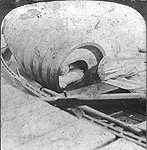
An historical
picture of Annie Edson Taylor in her barrel following her plunge over the
Horseshoe Falls
courtesy of the Niagara Falls (Ontario) Public Library
CAPTAIN KLAUS LARSEN
1910
(Survived)
On September 18th 1910, Captain Klaus
Larsen was the only boater to show up in response to an advertisement by the
Niagara International Carnival Committee promoting a boat race through the
Whirlpool Rapids.
As the only participant, Larsen rode his
boat through the rapids to the Whirlpool. Larsen began the second leg of his
journey through the Lower Rapids (Devils Hole Rapids) on route to Queenston.
During this portion of his trip, Larsen's boat was swamped and Larsen was tossed
into the water within sight of Queenston.
Larsen was able to make his way to shore
and finished his trip to Queenston aboard the Great Gorge Railway.
On October 28th 1911, Captain Larsen made
a successful trip through the Whirlpool Rapids in his boat. Larsen successfully
repeated this same stunt on October 29th 1911.
LINCOLN BEACHY
1911
(Survived)

Lincoln
Beachy flying his biplane under the Upper Steel Arch Bridge
courtesy of the Niagara Falls (Ontario) Public Library
Lincoln Beachy was born in San
Francisco in 1887. At the age of 18 years, Beachy built his own dirigible.
He was a short man with a jutting jaw.
The first airplane to appear over Niagara
Falls came in June 1911 in response to a $1,000 prize offered to anyone piloting
an aircraft to attend the joint United States - Canadian International Carnival
at Buffalo and Fort Erie.
The airplane was a Curtiss biplane and was piloted by Lincoln Beachy an American
employed by Curtiss Aircraft Company of Nebraska. The Curtiss biplane had an
open cockpit and was a two winged plane.
On June 28th 1911 at 5:40 p.m., Beachy
took off from an airfield in Niagara Falls, New York climbing high into the sky,
Beachy circled his plane over the falls several times before diving down into
the mist of the falls to within twenty feet of the waters surface before flying
under the arch of the Falls View Honeymoon Bridge. Beachy continued to fly his
plane just above the river surface along the length of the gorge at a speed of
50 mph before climbing
back up high into the sky before he reached the two rail bridges. Lincoln Beachy
was the first person to fly under a Niagara Falls bridge.
Beachy was killed on March
14th 1915 during a flying
exhibition over San Francisco, California. Beachy's aircraft crashed into San
Francisco Bay.

Lincoln
Beachy sitting at the controls of an early aircraft
courtesy of the Niagara Falls (Ontario) Public Library
BOBBY LEACH
1910, 1911
(Survived)
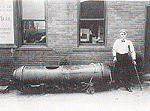
Bobby Leach
courtesy of the Niagara Falls (Ontario) Public Library
Bobby Leach had a reputation in England as
a circus stuntman. He had attracted attention to himself by announcing the
intention of becoming the first person to complete the "triple challenge". This
included:
1.) making a barrel trip through the
rapids to the whirlpool,
2.) going over the Falls in a barrel, and
3.) parachuting from the Upper Suspension
Bridge into the river upstream of the rapids.
On July 1st 1908, Leach jumped off the
Upper Steel Arch Bridge using a parachute to become the fourth (4th) person to
do so.
During the summer of 1910, Leach returned
to Niagara Falls to test his barrel. He attempted to ride the barrel through the
Great Gorge Rapids to the Whirlpool. Leach had attached an anchor to his barrel
but it was cut loose by rocks. Leach's barrel bounced from rock to rock through
the rapids before becoming stuck in an eddy in the Whirlpool. Leach was rescued
by William "Red" Hill Sr.. Hill had to risk his life by swimming out to Leach's
barrel and dragging it into shore. Leach was removed from the barrel
unconscious. Hill Sr. climbed into the barrel and rode it through the lower
rapids to Queenston. During that summer, Leach made three (3) other successful
trips through the famous Whirlpool Rapids.
In addition, Bobby Leach made two aborted
attempts to swim across the Niagara River down river from the American Falls.
On the afternoon of July 25th 1911, Bobby
Leach climbed into an eight foot long steel drum at Navy Island where the
current of the Niagara River veers towards the Canadian shore. The drum was
released at 2:55 p.m.. It took eighteen minutes to reach the brink of the
Horseshoe Falls before going over. It took 22 minutes to recover the drum. It
had become stuck in the river at the base of the falls before Fred Bender (an
Ontario Power Company employee) tied a rope around his waist and swam to where
the barrel was. Bender tied a rope to the barrel and it was hauled to the
Canadian shore. Leach was removed from the drum and rushed to the hospital
suffering from two broken knee caps and a broken jaw.
Twenty three weeks later, Bobby Leach left
the hospital and went on tour with his barrel throughout North America and
Europe. Leach did return to Niagara Falls to parachute from an airplane.
On July 1st 1920, Bobby Leach jumped using
a parachute from an airplane. He repeated this feat again on October 10th 1925.
In both cases Leach landed in corn fields on Canadian soil near the Niagara
Gorge. Records are vague as to his parachute jump.
While in Niagara Falls, Bobby Leach
purchased and operated a restaurant.
In April of 1926, Bobby Leach died at the age of 70 years in
Christchurch, New Zealand as a result of an accidental slip on an orange peel
while on his daily walk. His fractured leg had become infected and was
amputated. Two months later he died in hospital.
OSCAR WILLIAMS
1911
"THE GREAT
HOUDIN"
aka:
OSCAR WILSON
(Survived)
Oscar Williams (a.k.a. Oscar Wilson) came
to Niagara Falls in June of 1911. Williams called himself "The Great Houdin".
He was a steeplejack by trade and lived in Niagara Falls, New
York.
Niagara Falls,
New York - June 14th 1910
The Great Houdin, a tight-wire performer, entertained a holiday
crowd this afternoon at an international carnival here, but
hardly in the manner he intended. He was on the programme for a
trip across the Niagara Gorge on a quarter inch diameter cable,
holding fast by his teeth. His wire was stretched 100 feet north
of the Upper Steel Arch Bridge, a point where it was intended
his feat would be witnessed by a crowd of 80,000 assembled on
the State Reservation, as well as in Queen Victoria Park.
He mounted his wire and began sliding from the New York bank
toward the Canadian shore. Houdin was waving the flags of both
countries as he slid along the wire. A slope was planned for the
wire, but the weight of his body quickly pulled the strand,
making it too slack. Houdin had to stop at a point over the
centre of the river approximately 1,100 feet from the American
shore and still 600 feet away from completing his journey. For a
few minutes the immense audience applauded his feat, but when he
did not continue toward Canada It was apparent that he was in
difficulties, which he indicated by waving flags.
Awe-stricken, the
crowds looked on while the man, diminutive in form, struggled to
retain his hold on the small pulley from which he was suspended.
Houdin grabbed the cable with both his hands and then crossed
his legs over the wire and hung that way for 45 minutes until he
could be rescued. Houdin was not more than 200 feet north of the
Upper Steel Arch Bridge that had been closed to traffic sometime
before his scheduled trip however there were several hundred
people on the bridge watching as events unfolded
Firemen were
called and responded with several hundred feet of rope. A loop
was tied in the rope around the cable with about 300 feet on one
side and several hundred feet on the other. One end was thrown
over the bank and the foreman slid it along on the cable by
walking along on the bridge. Houdin had shifted his position
repeatedly and when the rope finally neared him, he almost lost
his balance as he reached for it, so eager was he to accept the
succor offered. When it was seen that he had grasped the rope, a
cheer went up from the anxious crowd that could be heard above
the roar of the great cataract. When it reached Houdin the rope
was cast off from the bank and it dropped to the lower river
where the steamer Maid of the Mist observing that something was
amiss picked up the lower end. The little steamer struggled with
the current, but kept well under Houdin, who safely lowered
himself hand over hand to reach the boat, a distance of nearly
200 feet. Another great cheer arose when Houdin was hauled
safely aboard and sank to the deck completely exhausted.
Houdin's real name was Oscar Williams, a steeplejack from
Niagara Falls, NewYork.
Niagara Falls, New York - June 28th 1911
On June 28th 1911, Houdin returned to Niagara Falls to mark the
closing of the annual Niagara International Carnival. Other star
performers included Lincoln Beachey and Robert Leach. A crowd of
300,000 spectators had gathered to watch the events.
Leach shot the Whirlpool Rapids in a steel barrel where he
became stranded in the whirlpool before being rescued. Beachey
had flown his bi-plane over the Horseshoe Falls and under the
Upper Steel Arch Bridge the day before without incident. Today
Beachey battling high winds narrowly escaped crashing into the
river below.
Houdin had undertaken to repeat his failed feat from the
previous year by sliding by his teeth across the Niagara Gorge
situated under the Upper Steel Arch Bridge. This time Houdin
began his slide for life on the Canadian shore. Within 100 feet
of the American shore, Houdin became stranded once more because
of a slack wire. Houdin remained marooned until he was hauled
ashore by rope.
PETER LANGAARD
1911
(Survived)
On October 24th 1911, Peter Langaard
successfully navigated the Whirlpool in a boat. Langaard's boat struck a
piece of driftwood while circling the Whirlpool losing the propeller from his
boat motor.
Without power, Langaard was stranded in
the Whirlpool for four hours and twenty minutes before being rescued.
CHARLES STEPHENS
1920
(Died)
Charles Stephens came to Niagara Falls to
challenge the Niagara River during the summer of 1920. Stephens was a 58 year
old barber from Bristol, England. He was the father of eleven children. His wife
was named Annie. He had acquired a reputation of daredevil in Europe where he
made a number of high dives and several parachute jumps. In Bristol, England he
was known as the "Demon Barber of Bristol".
On July 11th 1920, Charles Stephens went
over the Horseshoe Falls in a barrel made from Russian oak. Bobby Leach advised
Stephens not to make his journey until Stephen's barrel was perfected. Stephens
refused because he thought Leach did not want him to be a success like Annie
Taylor and Bobby Leach. Leached asked William "Red" Hill Sr. to speak to
Stephens.
Hill Sr. suggested that Stephens send his
barrel over the Falls unoccupied for the first time as a test but Stephens
refused. The barrel was heavy and had straps for Stephens arms. As ballast,
Stephens strapped an anvil to his feet while Leach and Hill Sr. looked on in
amazement and horror. Charles Stephens was a stubborn man. He was reluctantly
persuaded to take a small tank of oxygen with him. He wore only padded clothing.
Because of the possibility of the police
trying to stop him, Stephens decided to begin his trip over the Horseshoe Falls
with little fanfare at 8:10 a.m.. Stephens left from Snyder's point located
about three miles upstream from the Falls. Leach was so certain that a tragedy
was going to take place that he left not wanting to watch. Stephens went over
the brink at 8:55 a.m.. When the huge barrel hit the water at the base of the
waterfall, the anvil which was tied to Stephens feet was propelled through the
bottom of the barrel taking Stephens to his death.
The remnants of the barrel remained
trapped at the base of the Falls until its iron rings broke away. When
recovered, only the tattooed right arm of Stephens was still strapped in the
harness. The tattoo read "Forget Me Not Annie".
Stephens arm is buried in an unmarked
grave at Drummond Hill Cemetery in Niagara Falls, Ontario.
Charles Stephens became famous for being
the first of the barrel stunters to die challenging the Falls.
It would be eight years before another
daredevil would challenge the river again.
In 1991, the only surviving child Viola
Cogan age 81 years visited the Horseshoe Falls. Ms Cogan was present in 1920
when her father made his fatal plunge.
VINCENT TAYLOR
1927
(Survived)
On September 5th 1927, Vincent Taylor, an
Australian daredevil, made a parachute jump from the Upper Steel Arch Bridge.
JEAN LUSSIER
1928
(Survived)
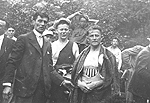
Jean Lussier
(right) posing with William "Red" Hill Sr. (center)
courtesy of the Niagara Falls (Ontario) Public Library
On July 4th 1928, Jean Lussier a 36 year
old French speaking man from Springfield, Massachusetts came to Niagara Falls
and made history by going over the falls in a rubber ball and by being the first
person to utilize an inflated rubber craft instead of the more conventional
wooden barrel or steel drum.
Joseph Albert Jean Lussier was born in
Concord, New Hampshire. His French Canadian parents moved back to Quebec shortly
after Lussier was born. At age 16, Lussier returned to New Hampshire in order to
learn English. Lussier was working in a grocery store when he heard about the
Charles Stephens tragedy in Niagara Falls. Lussier went on vacation to Niagara
Falls and to learn more about Stephens fatal ride over the falls in a barrel.
Lussier became interested in challenging Niagara Falls himself.
With a design in mind, Lussier went to an
Akron, Ohio rubber company to develop his idea. Lussier put up his life savings
of $1,500 to finance his dream. It was called a rubber ball being six feet in
diameter with inner and outer steel bands. It was lined with thirty-two inner
tubes for shock protection with an empty space in the middle for himself
including an air cushion. Lussier weighed 154 pounds. The rubber ball had 150
pounds of hard rubber ballast for the bottom to keep the ball from spinning head
over bottom. Lussier had devised a system of valves to provide air from tanks
containing enough oxygen to keep him alive for forty hours just in case he was
trapped under the waterfalls.
On July 4th 1928, Lussier managed to elude
police and rowed his ball out to the middle of the Niagara River about two miles
upstream of the Horseshoe Falls. Here the ball carrying Lussier was cut free and
began its journey towards the falls. The 150 pound ballast bottom was ripped out
from the bottom before the ball reached the crest of the falls. At 3:35 p.m.,
the rubber ball went over the Horseshoe Falls. Three inner tubes burst and the
frame was badly damaged. At 4:23 p.m., the rubber ball was picked up by the Maid
of the Mist boat and towed back to shore. Lussier sustained only minor bruising.
In order to profit from his success,
Lussier began selling off pieces of his rubber ball to tourists. When he sold
out Lussier began selling pieces of rubber that he would purchase from a near by
tire store. At the beginning of World War Two, Lussier was rejected from service
because of his age. Lussier worked in a defense factory until the end of the
war.
In 1952, at the age of 61 years Jean
Lussier had a dream of being the only man to ever go over the American Falls as
well as the Horseshoe Falls. Lussier began making plans for another ball device
twice as big as the rubber one he had used over the Horseshoe Falls. This ball
would be 12 feet in diameter and weigh 550 with him included. The ball would
have three layers made of cork, aluminium and rubber with a series of braces. The
inner ball would be mounted on roller bearings in order to stay upright at all
times. In addition it would have a forty-eight hour air supply and a radio
system. The dream ended with Jean Lussier's advanced age. He retired in 1958 as
did his dream.
Lussier died in his mid 70's
while living in Niagara Falls, New York.
GEORGE L. STRATHAKIS
1930
(Died)
In 1930, George Strathakis came to Niagara
Falls to challenge the Niagara River. He was a 46 years old bachelor.
Strathakis was born in
Greece in 1916. Before emigrating from Greece, he had become a religious mystic.
With no previous experience, Strathakis saw a way of raising money for the
publication of his books on metaphysical experiences.
George
Strathakis lived in Buffalo, New
York where he was employed as a chef. Strathakis however wanted to become a
professional writer.
Strathakis wrote in one of his yet
unpublished books that he was born a thousand years ago on the banks of the
River Abraham in Central Africa. He spoke of Niagara Falls in a mystical sense.
Strathakis would often take a rowboat into
the Niagara River. Each trip would take him closer to the Falls and the roar of
the great thunder. The death of Charles Stephens in 1920 and the success of Jean
Lussier in 1928 provided Strathakis with the desire to follow in their
footsteps.
Strathakis and his friends began building
a barrel. His plan called for the creation of a two thousand pound vehicle.
Rather than build on the successful design of Lussier's rubber ball, Strathakis
decided to construct his barrel on the basic design utilized by Charles Stephens
by using lots of wood and steel. The size and strength of Strathakis' barrel
proved impressive.
Strathakis rode his barrel over the
Horseshoe Falls on July 5th 1930. The barrel survived undamaged. George
Strathakis made one very serious miscalculation. He had taken with him an air
supply for only eight hours. Strathakis' barrel became stuck behind the Falls
and was held for twenty-two hours before being released in an eddy. When the
barrel was recovered and the lip opened, Strathakis had died of suffocation.
Strathakis had taken his fondest friend - pet turtle "Sonny" with him in the barrel. The
turtle which was believed to be 150 years old, survived the journey.
The medical examiner was Doctor W.
Thompson. Following his death, no one claimed the body of George Strathakis.
Of the seven human bearing barrels to go
over the Horseshoe Falls, Strathakis' barrel was the only one to ever get caught
behind the wall of water.
One year later, Red Hill Sr. would ride in
Strathakis' barrel through the rapids and the whirlpool.
WILLIAM "RED" HILL Sr.
1930
(Survived)

William "Red"
Hill Sr.
courtesy of the Niagara Falls (Ontario) Public Library
William "Red" Hill Sr. was born in Niagara
Falls, Ontario in 1888.
On May 30th 1930, a large crowd estimated
at twenty-five thousand lined both sides of the Niagara River from the Horseshoe
Falls to Queenston - Lewiston to witness a spectacular feat performed by
legendary river man William "Red" Hill Sr. At the age of 42 years, Hill Sr. was
going to fulfil his promise to challenge the Great Gorge Rapids and the
Whirlpool from the docks of the Maid of the Mist .
Hill Sr.'s barrel was of steel
construction, six feet long and three feet in diameter. Its interior was only
five feet long because Hill Sr. had built in six inch bulkheads at both ends.
This barrel had a fourteen inch by eighteen inch manhole to allow entry which
was covered by a sliding steel cover sealed with rubber gaskets. There were air
holes on the sides of the barrel with were plugged with cork to allow them to be
opened in an emergency. It was weighted by a steel keel welded to its bottom
consisting of a one hundred and fifty pound section of railroad track. The
barrel was equipped with a harness system so that Hill Sr. would lay prone but
suspended away from the walls. The barrel weighed 620 pounds and was painted
bright red with gold lettering with "William Red Hill, Master Hero of Niagara
inscribed on the sides.
At 1:15 p.m. May 30th 1930, Hill Sr.
climbed into the barrel and set off on his journey. Because of the eddies it
took Hill Sr. one hour and forty minutes before the river released his barrel
and he was allowed to continue. His trip through the rapids to the whirlpool
took ninety seconds. At the whirlpool, the barrel became stuck in the vortex.
After three and a half hours, Hill Sr. and his friends were able to free the
barrel so Hill Sr. could resume his trip to Queenston - Lewiston. Hill Sr.
arrived at the Queenston docks at 6:15 p.m. where he was met by thousands of
people including his wife and sons Red Jr., Major and Norman. He suffered a few
minor bruises. He went back to work driving a taxi the next day.
This was Hill Sr.'s second trip through
the rapids. His first performance occurred in 1910 using the barrel of Bobby
Leach. Red Hill Sr. made his third trip through the same rapids on Memorial Day
1931, using the barrel of George Strathakis. Strathakis died in this barrel
while attempting to go over the Falls on July 5th 1930. Hill Sr. survived this
trip as well but the barrel had sprung a leak and was half full by the time it
reached the Whirlpool. Again the barrel became caught in the vortex. Only
through the heroic efforts of his son William "Red" Hill Jr. who swam out with a
rope attached to his waist to tie onto the barrel did Hill Sr. survive.
The next day Hill Sr. went back to the
whirlpool and continued his journey in the barrel to Queenston.
Red Hill Sr. had officially been credited
with saving the lives of twenty-eight persons from drowning. He received more
lifesaving awards from the Canadian Government than any man before or since.
Red Hill Sr. was the foremost expert in
the knowledge of the rivers treacherous tides, undertows, whirlpool and eddies.
He had grown up near the gorge and it was his playground. During his lifetime,
Red Hill Sr. recovered the bodies of one hundred and seventy-seven persons who
had died from accidents or suicides.
Hill Sr. was a mighty swimmer, once having
swam from the foot of the American Falls through the boiling cauldron to the
Canadian shore in a record time of eleven minutes. He won his first Canadian
Government lifesaving medal at the age of nine years.
In February 1912, a spectacular tragedy
known as the "Ice Bridge Disaster" turned the spotlight on Hill Sr. in a large
way. Shifting winds sent thousands of tons of ice from Lake Erie over the Falls
into the gorge below creating a massive ice jam as thick as a hundred feet.
Prior to 1912 both American and Canadian Governments tolerated persons crossing
over the ice bridge or building shacks.
Near noon on Sunday February 4th 1912, in
below zero temperatures, the ice bridge began to shake and groan. Red Hill Sr.
was sitting in one of the shacks with several of his friends. Hill Sr. sensed
that the ice was breaking up and made a dash to the Canadian shore. A short
distance away he saw a small group of tourists who appeared frozen by fear. Hill
Sr. went back to them and ushered them to shore with the exception of four
people. An ice flow broke loose carrying a pair of newly weds, Mr. & Mrs.
Ellwood Stanton of Toronto and an eighteen year old would be rescuer Burrell
Peacock of Cleveland. All three persons died as the ice flow on which they were
riding reached the Great Gorge Rapids.
On August 8th 1918, a scow engaged in
dredging had broken loose of its mooring above the upper rapids and drifted out
of control towards the Horseshoe Falls. Gustave Luffberg and Frank Harris, both
dredging employees were on board the scow. Frantically, they opened the two
holes in the bottom of the scow dropping its load. As a result the scow became
caught on reef rocks only several hundred feet from the brink of the Falls. A
rescue boat could not be utilized to rescue the two men . The United States
Coast Guard however were called from Youngstown, New York to assist. When they
arrived they mounted their gun on the roof of the Toronto Power House. The first
shot to the scow with a rope was successful. A line was strung from the power
house to the scow. A breeches buoy followed the line but became snarled half way
across.
With night approaching, Red Hill Sr. went
out hand over hand along the rope as his body was tugged by the current of the
rapids. Red Hill Sr. reached the tangled breech buoy and was unable to untangle
it in order to allow the rescue of the crew of the scow without any loss of
life.
Hill Sr. spent the waning years of his
life showing off his barrel and selling pictures of himself in a souvenir store.
On May 14th 1942, William Red Hill Sr. at the age of 54 years, died of a heart
attack at the Niagara Falls Hospital.
WILLIAM "RED" HILL Jr.
1945
(Died)
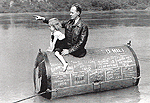
William "Red"
Hill Jr. posing in the Whirlpool
courtesy of the Niagara Falls (Ontario) Public Library
William "Red" Hill Jr. had to fill the
shoes of his father in order to carry on the dramatic multi-headlined legend
that his very name demanded that he uphold. There is no doubt that he tried. Red
Hill Jr. had helped out on most of his fathers twenty-eight rescues. He helped
his father in the recovery of 117 of 177 corpse recovered.
On his own Red Hill Jr. pulled another 28
dead bodies from the river.
Red Hill Jr. twice made the strenuous and
dangerous swim from the base of the American Falls to the Canadian shore, but he
failed to equal his fathers time of eleven minutes.
In order to match his father, Hill Jr.
twice conquered the Great Gorge Rapids and Whirlpool in a barrel.
Red Hill Jr. made his first trip on July
8th 1945. A crowd of two hundred thousand had lined the banks of the Niagara
River to watch this spectacle. In order to thwart the police the exact time and
starting point were not given advance notice. Hill Jr. would be using a six feet
long, 720 pound all steel barrel. In order to create a diversion of his own he
announced at 2:00 p.m. he would launch at the Maid of the Mist dock while
knowing full well that the police would be there to stop him. The decoy strategy
worked perfectly. The bright red barrel had already been lowered down into the
gorge just upstream of the rapids during the predawn hours.
Shortly after 2:00 p.m., Red Hill Jr.
climbed into the barrel and set out on his journey. It was immediately caught in
the forty-two mile per hour current and drawn into the rapids. Just before
reaching the actual rapids, the barrel was struck by a cross wave and tossed
twenty feet into the air and somersaulting twice before landing back into the
churning water. As the barrel hit the Whirlpool it was caught by the vortex. Red
Hill's brothers Major and Norman rowed out and brought the barrel to shore. Hill
Jr. complained of dizziness but climbed back into his barrel to complete his
journey to Queenston.
After completing the two and a half hour
trip, Hill Jr. and his mother went to Fairview Cemetery to lay a wreath on his
fathers grave. Later that evening, Hill Jr.'s mother suffered a heart attack.
Red Hill Jr. made his second trip through
the rapids on September 6th 1948. This time Hill Jr. used a barrel weighing
approximately one thousand pounds. This trip started the same as the first when
the barrel was tossed approximately forty feet in the air by a wave. Within five
minutes the barrel entered the Whirlpool where it spun out of control for more
than an hour. From time to time the strong vortex of the Whirlpool actually
pulled the huge barrel under the water surface. Again his brother saved Hill Jr.
by pulling the barrel to shore. Hill Jr. was badly bruised. Hill Jr. bailed out
water from the barrel for an hour before he climbed back into it to continue his
journey to Queenston. Hill Jr. arrived at the Queenston dock after his four and
a half hour ordeal.
Red Hill Jr. acquired fame but the fortune
eluded him. A month after his second ride, a bailiff seized all of his goods and
chattels for sale at a public auction in order to satisfy three creditors. All
three barrels the Hill family had were taken away as well and sold for
twenty-nine hundred dollars.
On the last Saturday of July 1949, Major
Hill decided it was time to restore the legends financial status. Major Hill age
38 years, challenged the Great Gorge Rapids in a 625 pound torpedo shaped steel
barrel. The barrel took such an awful pounding that Major Hill had to be hauled
up the gorge in a basket and hospitalized. Major Hill's journey was a failure in
terms of media coverage and financial.
The dream of a fitting memorial to Red
Hill Sr. weighed heavily on the shoulders of Red Hill Jr. It was because of this
unfulfilled desire the Hill Jr. began planning to ride over the Horseshoe Falls.
Red Hill Jr. age 38 years, set his date
with destiny for August 5th 1951. Because of the lack of funds and support Hill
Jr. had to build a cheap barrel. Hill Jr. constructed what he would refer to as
"the Thing", a contraption consisting of thirteen large heavy duty inner tubes
lashed together by three inch wide canvass webbing. These were then encased in a
heavy gauge fish netting. Hill Jr. painted his contraption silver with the words
"The Thing" inscribed all around the tube.
The tube was launched at 1:30 p.m. from
Ushers Creek located on the Canadian shoreline approximately three miles
upstream from the Horseshoe Falls. At 3:30 p.m. the tube with Red Hill Jr.
inside rode through the upper rapids to the brink of the Horseshoe falls and
over. The vast crowd was silenced. The Thing was caught under the extreme
pressure of the falling water and broken apart.. It was two minutes before parts
of the rubber tubes began to surface. There was no sign of Red Hill Jr. The
silence was shattered by Hill Junior's mother frantically calling out for him. Hill
Junior's wife and ten year old daughter joined his mother for the long vigil while
his brothers: Major, Norman & Wesley searched for his body.
The next morning the badly battered body
of William Red Hill Jr. was found near the Maid of the Mist dock. The lower part
of his body was badly mangled and his forehead had a large laceration. He was
buried the following Thursday at Fairview Cemetery in Niagara Falls, Ontario.
Following the death of Red Hill
Jr., there was a public outcry over his needless death. This public condemnation
resulted in then Ontario Premier: Leslie Frost to issue a special order to the
directors of the Niagara Parks Commission to arrest anyone who commits an act of
stunting upon the properties of the Niagara Parks. Since that day, no permission
has been granted to allow any stunting within the park.
MAJOR LLOYD HILL
1949
(Survived)
Major Lloyd Hill was following in the foot
steps of his famous daredevil family. He was the son of William "Red" Hill Sr.
and the brother of William "Red" Hill Jr. both accomplished daredevils of
Niagara.
On July 30th 1949, Major Lloyd Hill using
a six hundred and fifty (650) pound barrel successfully navigated the Whirlpool
Rapids. Hill became stranded in the Whirlpool and had to be rescued by the City
of Niagara Falls Fire Department.
Major Hill caused quite a controversy the
next day when he climbed back into his barrel and continued his journey through
the Lower Rapid (Devils Hole Rapids) to Queenston. This portion of Hill's
journey was successful.
On August 6th 1950, Major Lloyd Hill
navigated the Whirlpool Rapids in a barrel and circled the Whirlpool twice
before floating to the calm waters near shore. Major Hill's barrel was towed to
entrance to the Lower Great Gorge before being released to continue his journey
to Queenston.
Hill's journey took two hours and 45
minutes, beating his brothers previous record of five hours.
On July 31st 1954, Major Lloyd Hill made
his third successful trip through the Whirlpool Rapids in a barrel. When Hill
arrived at the Whirlpool, he came ashore at Colts Point terminus of the Spanish
Aero Car. Here Ontario Provincial Police were waiting to greet Hill. Major Hill
was taken from the scene by the police. Hill was not charged but the police had
interrupted Hill's plan to continue to Queenston.
On July 30th 1956, Major Lloyd Hill again
rode through the Whirlpool Rapids in his barrel. Hill was stranded in the
Whirlpool for three hours before floating close enough to shore. Hill jumped out
of the barrel and swam to shore dragging the barrel behind him. The barrel by
this time had been partially filled with seventy-nine gallons of water.
In a subsequent parachute
accident, Major Hill severely injured one of his legs that was later amputated.
Major Hill was murdered in 1974
in the City of Niagara Falls, Ontario.
TED MERCIER
JOSEPH HAWRYLUK
SCOTT
GRAHAM
1954
(Survived)
On August 18th 1954, teenagers, Ted
Mercier, Joseph Hawryluk and Scott Graham swam across the Niagara River from the
Canadian shore near Seneca Street to the American shore approximately 400 yards
downstream. The river current had carried the youths this lengthy distance from
their starting point. The boys were not charged by the police for their
accidental prank.
CLAUS R. KIRKOFF
1957
(Survived)
On October 1st 1957, Claus R. Kirkoff, a
former German swimming instructor successfully swam through the Lower Rapids
(Devils Hole Rapids) in an attempt to gain illegal entry into the United States
of American from which he had been previously deported.
Kirkoff had earlier tried to cross into
the USA on the mistaken belief that the Spanish Aero Car would carry him across
the border. He did not know that the Spanish Aero Car crosses the width of the
Whirlpool from Canadian terminus to Canadian terminus.
ROGER WOODWARD
1960
(Survived)
|
Special Note
Roger Woodward was a victim of a
tragic set of circumstances that resulted in the death of Mr. James
Honeycutt. Roger Woodward and his older sister Deanne narrowly escaped with
their lives.
Roger Woodward was
not a
daredevil or a stunt man. The fact that he was swept over the
Horseshoe Falls was not his choice by design or otherwise.
The story of this tragic accident is
listed under this section not because Roger Woodward was a daredevil but
rather his survival was nothing less than a miracle. |
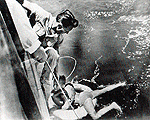
A historic
picture of Roger Woodward being rescued
by the crew of the Maid of the Mist
courtesy of the Niagara Falls (Ontario) Public Library
On July 9th 1960, a seven year old boy
named Roger Woodward became the first person to survive a plunge over the Falls
without a barrel.
Woodward and his 17 year old sister
Deanne, both of Niagara Falls, New York set out that day on a harmless boat ride
on the upper Niagara River with family friend James Honeycutt. Honeycutt , age
40 years, of Raleigh, North Carolina, was a contractor at the Niagara Parks
Commission hydro project. He had often taken the Woodward children out for a
boat ride on his fourteen foot long aluminum boat with a seven and a half
horsepower outboard motor. Mr. & Mrs. Frank Woodward trusted Honeycutt
completely.
Honeycutt and the Woodward children began
the boat ride about five miles upstream of the Falls where Honeycutt was living
in a house trailer at the Lynch Trailer camp along the American shoreline.
Approximately one mile upstream of the
Horseshoe Falls, Honeycutt began to turn the boat in the opposite direction when
the boat motor malfunctioned and quit running. On examining the engine,
Honeycutt discovered that the propeller pin had sheared off. Honeycutt began
rowing frantically towards the shore but the current was carrying the boat ever
so quickly towards the Falls. Honeycutt ordered the Woodward children to put on
their life-preservers. Honeycutt was too busy rowing to have time to put his
life-preserver on.
Near the Falls the waves capsized the boat
separating Deanne from her brother Roger and Mr. Honeycutt. Deanne held onto the
side of the boat until a wave forced her under water. When she surfaced, she saw
two men standing on the shore. John Hayes, age 44 years, a truck driver from
Voxhall, New Jersey was visiting Terrapin Point on Goat Island when he saw
Deanne in the water. Hayes grabbed Deanne by her fingers and called for help.
John Quattrochi, age 39 years, a tourist from Pennsgrove, New Jersey came to
help Hayes. Both men successfully pulled Deanne from the water.
Roger Woodward was in Honeycutt's arms as
they approached the Horseshoe Falls. The raging water pulled them apart as they
rode over the crest of the Falls. Roger Woodward was wearing swimming trunks and
a pair of running shoes. The shoes were ripped from his feet on his way down the
cascade. Woodward was forced into the 180 foot deep water at the base of the
Falls but was quickly freed where he floated to the surface.
It was 12:55 p.m., when the crew of the
Maid of the Mist spotted tiny Roger Woodward bobbing up and down in the water.
Captain Clifford Keech was at the wheel of the 270 foot long Maid of the Mist
II. After eight minutes and three approaches to rescue Roger Woodward by using a
life ring.
Roger Woodward was taken to the Greater
Niagara General Hospital in Niagara Falls, Ontario. He sustained only minor cuts
and bruises. Deanne Woodward was taken to Memorial Hospital in Niagara Falls,
New York suffering from nothing more than shock James Honeycutt was battered and
drowned.
NATHAN T. BOYA
aka: WILLIAM A. FITZGERALD
1961
(Survived)
On July 15th 1961, Nathan T. Boya, age 30
years, a black man from the Bronx in New York challenged the mighty Falls
unannounced and emerged virtually unscathed. Boya claimed the trip was not for
fame or fortune but rather for personal reasons.
The craft the Nathan Boya had built was a
sphere of steel frame construction six feet in diameter. Covering the steel
frame was a six ply rubber cover followed by a sheet metal cover and another ply
of rubber. The ball was nicknamed "Plunge-O-Sphere" and weighed 1,200 pounds
including Boya's own weight.
Learning from the past, Boya installed an
oxygen system capable of providing air for thirty hours. Inside the sphere Boya
carried a banner which read " Plunge-O-Sphere, Step from your PIT OF DARKNESS,
into the light - Dell". Boya refused to say what the meaning of the banner was.
Boya launched his craft from an
undisclosed location upstream of the Falls along the American Shoreline. It
appears that the sphere containing Boya was towed into Canadian waters,
otherwise the sphere would have gone over the American Falls instead of the
Horseshoe Falls.
A week before Boya made his journey he met
with Jean Lussier who made his own trip over the Falls July 4th 1928. Lussier
advised Boya to insure his safety by taking sufficient oxygen with him. Boya
added 13 canisters of oxygen and a re-breather a device which converts carbon
dioxide to oxygen.
Boya said he had been in the water a good
length of time before reaching the upper rapids. Boya said when he entered the
rapids the sphere felt like it dropped fifty feet. The sphere was upside down
for several moments before righting itself. Boya's sphere went over the
Horseshoe Falls nearer to the American side. Boya said he didn't feel the fall
over the Falls except when the sphere bounced off a rock at the bottom causing a
large dent to the outer skin of the ball. during the trip Boya opened the hinged
door in his craft to view his progress. Boya was pawing at the hatch to pull it
down when the Maid of the Mist launch the "Little Sister" came along side of the
sphere and a police officer arrested Boya for his journey without the permission
of the Niagara Parks Commission.
Boya was subsequently fined $100 plus $13
court costs in Niagara Falls Ontario Provincial Court.
Nathan Boya remained a mystery man. He
refused to provide any information about his occupation other than to say he was
self employed. Several news reports said that Boya was really William A.
Fitzgerald, a maintenance man at IBM. Headquarters in New York, New York. Boya
denied these reports however a check of the address he had given in the Bronx
revealed no one by the name of Boya lived there. When asked about his feat, Boya
said he did not consider it to be a daredevil stunt but that it was just
something he had to do.
Nathan Boya was the seventh person to
conquer the Falls and live. He returned to Niagara Falls only once, on July 15th
1962, the first anniversary date of his plunge.
Nathan Boya became a doctor after
earning a doctorate in sociology and post doctorate medical behaviour. He became
a Fellow of Faculty at a medical school in New York City.
Joseph M. Caligiuri, Sr., and his brother Henry Caligiuri were
partners and owners in a company known as Hudson Fixtures. It was located on
138th Street n the
Bronx, New York. Henry Caligiuri
was the architect and Joseph was the salesman for the business.
They were approached by daredevil Nathan Boya and asked to design and build a
steel spherical shaped contraption that Boya used in his journey over Niagara
Falls.
Nathan Boya contracted
Hudson Fixtures to build a ball to go over Niagara Falls because he wanted to
impress his girlfriend.
Together, Joseph and Henry Caligiuri built the ball that went over the falls
with Nathan Boya.
Joseph was concerned that if the ball hit a rock where the entrance hatch was
located, Boya might not live to tell the story. As a result of his concern
Joseph added rubber air-filled inner tubes inside the contraption to float the
ball. In an emergency the air from the inner tubes would allow Boya extra oxygen
to breathe to give him more time until he could be rescued. Fortunately, the
dent in the ball was not on the hatch.
Following the successful feat of Nathan Boya, Mr. Joseph Caligiuri Sr. was
invited to appear on the television show "What's My Line”. Unfortunately Joseph
was the last person scheduled to appear on the show, they ran out of time before
he could appear. The show producers asked Mr. Caligiuri to return to the show
but he felt he had better things to do.
The design of the ball was
later published in the Popular Mechanics Magazine.
Courtesy of
Jeanne M. Caligiuri (daughter of Joseph Caligiuri Sr.)
RAYMOND WEAVER
1961
(Survived)
Raymond Weaver, a 39 year old man from
Niagara Falls, New York challenged the Great Gorge Rapids and the Whirlpool
during the summer of 1961.
Weaver had built a boat weighing eight
hundred pounds and containing six hundred pounds of ballast. It was fourteen and
a half long and of steel construction. The boat was constructed of twelve and
sixteen gauge steel plate and the top entirely covered as well. A three and a
half horsepower outboard motor propelled the boat.
At 5:30 a.m. on July 28th 1961, Weaver
began his journey near the Maid of the Mist dock. Weaver was strapped inside the
boat and was wearing a safety helmet. The boat successfully navigated the Great
Gorge Rapids. As it entered the Whirlpool, the boat motor had become water
logged and quit functioning. The vortex of the Whirlpool caught the boat and
held it in a vice grip for the following four hours before changing currents
allowed its release. Weaver completed his journey to the Queenston dock. The
total trip took seven hours to complete.
By now, technology and vessel construction
had improved significantly lowering the risk levels of the stunt participants.
Interest by the citizens and the media was beginning to wane.
KARL HEINZ KOCH
1964
(Survived)
During the summer of 1964, Karl Heinz
Koch, a swimming instructor from Germany was arrested by police for swimming in
the Niagara River approximately 200 yards downstream (north) of the American
Falls.
At the time of his arrest, Koch said "I
was hot and I didn't see any sign saying no swimming, so I took a little dip".
BRUCE CURTIS
RONALD HESS
1969
(Survived)
On July 14th 1969, Bruce Curtis and his
friend Ronald Hess of La Salle, New York survived a ride through the Lower
Rapids (Devils Hole Rapids) riding on a five and a half (5½) foot diameter
tractor inner tube. They said they did it because they thought it looked like
fun. Both boys regularly went swimming at Devils Hole.
JOHN KAZIAN
1971
(Survived)
On September 2nd 1971, John Kazian stood
on the wing of a single engine stunt plane piloted over Niagara Falls by Joe
Hughes. During this aerial exhibition, Kazian performed several other tricks as
well.
NIAGARA
WHITE WATER RAFT COMPANY
1972
(commercial business)
On May 23rd 1972, a fledgling commercial
enterprise named the Niagara White Water Raft Company made its first successful
trip through the Whirlpool Rapids in a white water raft.
On May 25th 1972, a second successful trip
was made through the Whirlpool Rapids in a similar raft. Passengers for this
trip were recruited from local media personnel and family members and friends of
the Niagara White Water Raft Company.
The rapids raft rides were discontinued on
August 14th 1972 following a number of accidents where passengers were thrown
into the turbulent water of the Whirlpool Rapids.
On August 20th 1972, the Niagara White
Water raft Company launched a shorter and much safer commercial raft ride. This
new ride took passengers from Lewiston, New York upriver to an area of the Lower
Rapids (Devils Hole Rapids below the Niagara Glen. This ride was successful but
only continued until September 1st 1972.
HENRI JULIEN RECHATIN
1974,1975
(Survived)

Henri
Rechatin crossing the Whirlpool along with his wife, Janyck and
motorcycle driver Frank Lucas
courtesy of the Niagara Falls (Ontario) Public Library
Henri Julien Rechatin was born in France
in 1932. He was the only son of his famous acrobatic parents, the Pierrodys. The
French speaking Rechatin was taught by his father to juggle and tumble. Rechatin
graduated to low wire balancing acts in circuses throughout Europe.
In 1966, at the age of 34 years, Henri
Rechatin set a world endurance record on high wire balancing. For two hundred
thirteen hours and fifteen minutes, Rechatin balanced himself on a wire cable
one thousand one hundred feet above the ground on a three thousand nine hundred
foot cable stretched across the Loire River Valley in France.
On January 14th 1967, Europe's top tight
rope artist came to Niagara Falls along with his wife Janyck. Henri Rechatin was
35 years old, weighed one hundred and fifty-eight pounds and was five feet seven
inched in height.
In order to bring back the fire of desire
and thrill to the citizens and media of Niagara to level only experienced in
yesteryear, Rechatin made several proposals to conduct high wire acts across the
Niagara River at various points along the gorge throughout the entire year. The
year 1967 was the Centennial Birthday of Canada and special celebrations were
being planned in cities and towns all across the Nation. Rechatin initially
proposed to perform a high wire act on a wire of less than one inch in diameter
across the one thousand eight hundred foot width of the Whirlpool approximately
two hundred feet above the churning waters below. Rechatin further proposed that
the first performance could take place on May 7th 1967. His wife Janyck would
assist him.
Henri Rechatin was a very experienced high
wire performer and had the credentials to back up his bravado. Rechatin quite
often drew similarities between the Great Blondin and himself. Rechatin vowed to
do trick that Blondin had performed and more.
On February 11th 1967, the Niagara Parks
Commission refused to allow the proposal of Henri Rechatin to take place.
Rechatin and his wife returned to their home in St. Etienne, France.
On May 26th 1975, Henri Rechatin and his
wife returned to Niagara Falls. This time he proposed to be the first person to
remove a straight jacket while hanging upside down form a helicopter while
hovering over the Falls. When authorities threatened Rechatin with charges if he
proceeded, it was sufficient for Rechatin to abandon that idea.
Shortly after 9:00 a.m. on June 3rd 1975,
Henri Rechatin appeared at the top of the Skylon Tower observation deck level
five hundred and twenty feet above the ground. Working from a small eight foot
by three foot wooden platform on the outer edge of the deck, Rechatin began a
chair balancing act only inches from instant death. Using two oak chairs,
Rechatin balanced the bottom chair on the wooden platform nearest the outer
edge. Rechatin placed the second chair on top of the first and balanced it so
that only the rear legs of this chair were touching the seat of the first chair.
Rechatin climbed sat onto the second chair and remained balanced without using
his feet or arms for support. Despite low clouds and mist from the Falls, this
act only lasted thirty seconds but Rechatin performed this same feat three times
in order to facilitate the media.
The very next day on June 4th 1975, at
4:30 a.m., Henri Rachatin, his wife Janyck and motorcycle driver Frank Lucas of
Toulouse, France assembled at the Southern terminal of the Spanish Aero car
above the Whirlpool. At 6:30 a.m., without permission and without fanfare, the
trio began crossing the Whirlpool on the existing cable that supported the
Spanish Aero car. Gradually creeping out onto the greasy cable, Lucas began to
drive his specially modified motorcycle. The cycle had a metal frame constructed
above it so that Rechatin could stand above it and a metal frame below the cycle
so that Janyck could hang upside down by one of her feet. This crossing had been
well planned in advance. In the middle of the crossing the wind began blowing
and the rear wheel on the motorcycle began slipping. Frank Lucas had no previous
experience. He did however win the French National Moto-Cross Championships in
1966, 1967, and 1968. When the trio had come within fifteen feet of the Northern
terminal (where the Spanish Aero Car is kept when closed) Rechatin took a
balance pole from the upper frame and began wire walking the rest of the way to
the shore. Rechatin then attached a rope to the motorcycle and pulled it as
close to the Aero Car as possible. Rechatin helped his wife and Lucas into the
Aero Car where they remained until the ride operator arrived for work at 7:30
a.m. Upon the arrival of the operator the Spanish Aero Car containing the trio
were returned to the Southern terminal where Police by now were waiting.
Rechatin was arrested for performing a dangerous act however formal charged
against him were not proceeded with.
In May of 1976, Henri Rechatin came back
to Niagara Falls with his wife and their eight year old daughter Corine.
Rechatin had arranged to perform a fifteen day wire walk endurance test on
Clifton Hill in Niagara Falls, Ontario beginning on the early morning of May
27th 1976.
Two forty-seven foot high steel towers
were constructed between Ripley's Believe It Or Not Museum and the Hollywood Wax
Museum located fifty-nine feet away. Utilizing a five-eighths of an inch
diameter cable, Rechatin would perform four acts per day for the tourists below.
Rachatins' only refuge was a wooden three foot by three foot platform nearest
the Ripley's Museum. Here he would eat, use for washroom purposes and take
twenty minute catnaps. Rachatin's fifteen day ordeal ended on June 7th 1976.
During his last performance, Rechatin carried a Niagara Falls Review newspaper
reporter named Christina
Montgomery age 21 years across the wire on his back.
On June 8th 1976, a Rechatin proposal to
wire walk across the Niagara River above the Falls was refused by New York State
Parks authorities. A 1995 Rechatin proposal to recreate his 1975 wire walk
across the Whirlpool on the cables of the Spanish Aero Car was refused by the
Niagara Parks Commission. In 2007, Henri Julien Rechatin is now 75 years of age.
On Friday
December 27th 2013, Rechatin died at the age of 82 years in
Saint-Etienne, France.
Christine
Montgomery describes her memories of this event:
I thought when
I met the Rechatin's they were lovely, very gracious and civil.
And funny, wickedly funny, as much as I could tell with my
modest knowledge of French. I don't know what I expected a
daredevil to be like, but it wasn't like that. They were a whole
family, just a normal family, but dedicated to his craft, his
tightrope. That summer, Janyck would appear below the wire he
was living on early every morning to send up food and dispose of
his toiletries and so on. I remember one morning they were
having a fight and he took his sleeping bag, which soaked up dew
overnight and got fairly heavy, and dropped it down on her. Just
straight down, with a thump, on her head. They were like that,
the joked and bickered and you almost forgot they were these
circus people. He was a consummate professional though, that's
what I remember. He talked a lot about his work, how every time
he worked a fair in France, he'd take people up on his back. It
was easy to see that for him, it was safe. It was just work. So
when he wanted to take someone on his back to show the parks
commission that he knew what he was doing, I really wanted to
go. One of the TV stations in Buffalo tried to talk him into
taking one of their reporters, but they insisted she have a net
under her, and Rechatin got in quite a huff about the
suggestion. He said no. I said I'd go, no net, no problem. My
boss was worried about the liability, so I got off work "early"
and went on my own time.
It was pretty scary. I'm deathly afraid of heights, but
curiosity overcomes a lot of my fears. In the end, I took a deep
breath and zoned out. If you die, you die, I figured. I went up
the tower beside his platform, stepped over a big gap onto his
own little platform and slid my legs through these straps he had
hanging from his shoulders. That's all that held me. He was
cracking jokes in French all the way across the wire on the
first pass, but he told me I couldn't laugh or I'd wreck his
balance -- and if he fell, his wife would kill him if the fall
didn't. At the other side there was no place to turn around,
just a tinier platform, so he backed up all the way on the
second pass. I thought it was hysterically funny; people down
below were gasping and making comments about how scared I must
be and that's why he was backing up. And then I slid off his
back, and we said goodbye. I remember looking him right in the
eye, since he was a little guy, about as tall as me, and
thinking: Wow. That was so cool, and for you it's all in a day's
work.
The only drag was when I came down and the American reporter,
who was angry she couldn't go, stuck a mic in my face and said
"So, is there anything you won't do for a story?". I was only
20, but I understood the concept of dead air, and I just stood
there. Which I thought was better than saying what I was really
thinking.
I was sorry later to hear he'd been denied permission to cross
over the gorge on his own wire. I know he'd have been fine.
-
Christine Montgomery
EDWARD A. FRIEDLAND
1974
(Survived)
On June 28th 1974, Edward Friedland a
wannabe stunt man rode a rubber dinghy through the Whirlpool Rapids into the
Whirlpool. Once in the Whirlpool, Friedland became stranded in the twirling
boat. A sightseeing helicopter made a dramatic flight into the Whirlpool Gorge
to rescue Friedland.
Friedland had planned this stunt in order
to draw attention to himself so that he might get a job as a stuntman with a
movie production company which happened to be making a movie in the Niagara
area.
JIM SARTEN
1975
(Survived)
Jim Sarten was a professional stuntman
working for Playboy Productions during the filming of the television movie "The
Great Niagara". As part of the production, the film company made a raft made
from a few planks and empty oil drums with the intention of floating it through
the Whirlpool Rapids. Permission had been received from both Governments with
the understanding that a dummy would be sent on the raft rather than a human.
The raft was designed by Wes Hill and Jim Sarten.
Wes Hill was in charge of all the water safety and river bank
safety on the set.
On July 4th 1975, as this stunt began, Jim
Sarten took the place of the dummy and rode the raft through the Whirlpool
Rapids to the Whirlpool.
Sarten was outfitted with a dive suit and air tank under his
costume in order to save his body from being bashed on the rocks
and the air tank had a small hose coming up thru his costume to
near his mouth so that he could grab it and use it if necessary.
Sarten was rescued by Wes
Hill from the Whirlpool
nearly dead. He had to be revived and rushed to hospital.
Playboy Productions was fined $75 for
allowing a stunt to be performed contrary to the Niagara Parks Act.
NIAGARA GORGE RIVER TRIPS INCORPORATED
1975
(3 Died)

Zodiac raft
following accident
In 1975, Niagara Gorge River Trips Inc.
began operation of a white water rafting business through the Whirlpool Rapids.
The raft utilized was a prototype rubber raft made by the Zodiac Company of
France.
On August 29th 1975, during the eleventh
trial run through the Whirlpool Rapids, with 29 passengers aboard and a crew of
four, the rubber raft capsized in the Whirlpool Rapids. All the occupants of the
raft were thrown into the rapids. Some of the occupants were trapped under the
overturned raft.
Three of the passengers died of drowning.
Miraculously, 30 people survived after a very heroic rescue by members of the
various emergency services in both countries.
MR. X
aka: James
Randi
1975
(Survived)
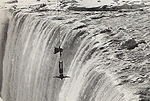
James Randi
dangling over the Horseshoe Falls
On February 7th 1975, an unidentified man
(Mr. X) working for a Toronto film company was dangled over the precipice of the
Horseshoe Falls at the Table Rock by a crane for five minutes while strapped
into a strait jacket.
This stunt was performed for a television
program and permission to conduct this stunt was received from the Niagara Parks
Commission.
KENNETH W. LAGERGREN
1977
(Survived)
On October 30th 1977, Kenneth Lagergren
and a friend known only as Charles rode together in a kayak through the
Whirlpool Rapids. Both survived the journey. Lagergren was arrested by the
Niagara Parks Police while his friend escaped apprehension.
Lagergren would challenge the Whirlpool
Rapids again in 1981 in a kayak during the filming of a television segment for
the ABC - TV network program "The American Sportsman". (see below)
KENNETH W.
LAGERGREN
CHRIS SPELIUS
DON WHEEDON
CARRIE ASHTON
1981
(Survived)
On October 14th 1981, professionals,
Kenneth Lagergren, Chris Spelius, Don Wheedon and Carrie Ashton rode through the
Whirlpool Rapids in kayaks in conjunction with the ABC - TV program "The
American Sportsman". All survived unharmed despite that one kayak tipped over
for twenty seconds before being righted.
The Niagara Parks Commission permitted
this exhibition because it was considered a sport.
KAREL SOUCEK
1977
(Survived)
1984
(Survived)
On June 11th 1977, Karel Soucek made a
successful trip through the Whirlpool Rapids in a barrel. In the Whirlpool,
Soucek became stranded for three hours. Upon his rescue, Soucek was arrested by
Niagara Parks police and charged with performing a stunt without a license.
On July 2nd 1984, Karel Soucek, age 37
years, of Hamilton, Ontario challenged the mighty Horseshoe Falls in a homemade
barrel. Soucek would become the first person to attempt the dangerous journey
over the Falls in twenty-three years.
Soucek was born in Czechoslovakia on April
19th 1947. Soucek
advertised himself as the "Last of the Niagara Daredevils".
Soucek began planning well in advance and
was talking publicly about his intentions for at least a year in advance.
On July 22nd 1976, Soucek attempted to
cross the Whirlpool on a moped by using the cables of the Spanish Aero Car. This
attempt failed after he had traveled twenty (20) feet (6m) when his moped hit a
bolt and was derailed. A safety harness worn by Soucek saved his life by
preventing him falling into the turbulent waters of the Whirlpool below.
Soucek
had built a specially designed barrel of lightweight metal and plastic with
enough ballast in one end to ensure a plunge feet first. The barrel was equipped
with a two-way radio. Soucek spent fifteen thousand dollars to prepare for his
journey. Soucek had previously rode an all steel barrel through the Great Gorge
Rapids to the Whirlpool on two occasions. Soucek's dream was to go over the
falls and become the fifth person to do so and live.
At around 9:30 a.m. on July 2nd 1984, four
assistants pushed the red colored barrel with Karel Soucek inside from the back
of a truck several hundred yards upstream of the Horseshoe Falls along the
Canadian shore. The barrel was launched without interruption. The barrel with
the name "Karel Soucek" written on its side in large letters moved quickly down
river and over the Horseshoe Falls at 75 miles per hour. The ballast worked
perfectly for the 3.2 second trip over the Falls. Soucek later described it as
similar to a skydiver's free fall. When the barrel hit the water below, it
rebounded causing the wristwatch on Soucek's left arm to strike his forehead
causing numerous facial cuts and bruises. For forty-five minutes the barrel
bounced off the rocks at the base of the Falls . Soucek who had lots of oxygen
just relaxed and awaited release by the changing water currents. When the barrel
was released it was quickly recovered and brought to shore.
Soucek walked away from the barrel and was
lifted to the surface and taken to the Greater Niagara General Hospital in
Niagara Falls, Ontario for minor cuts and bruises. Soucek was charged by the
police and his barrel confiscated. It was a dream come true for Soucek and he
became the eight person to conquer the Falls.
On July 11th 1984, Karel Soucek was fined
$500 in Niagara Falls Ontario provincial Court for his barrel stunt.
On January 19th 1985, Karel Soucek was
killed during a free fall stunt at the Houston Astrodome in front of forty-five
thousand spectators. A barrel measuring approximately six (6) feet long with
Soucek on board was lifted by a crane to the roof of the Astro Dome. When
released the barrel was to fall into a large tank filled with water. The tank
was ten (10) feet in diameter so the stunt was extremely difficult . When the
barrel was released, a piece of wood nailed to the bottom of the barrel struck
the side as it entered the tank. Foam pads which were supposed to have been
secured to the base of the water tank had floated to the surface before the
drop. As the barrel dropped the water and foam pads failed to cushion Soucek's
decent. The force of the sudden impact resulted in Soucek sustaining massive
internal injuries which resulted in his death.
Karel Soucek is buried at
Drummond Hill Cemetery in Niagara Falls, Ontario.
STEVEN TROTTER
1985
(Survived)
STEVEN TROTTER
LORI MARTIN
1995
(Survived)
On November 12th 1984, Steven
Trotter made his first attempt to go over Niagara Falls in a barrel. It was an
unsuccessful attempt when his barrel became hung up on rocks upriver of the
Falls. Trotter was in a barrel called "the Rig" which cost Trotter $6,200 to
build. Trotter was fined $500 in Niagara Falls Ontario Provincial Court.
During the summer of 1985, a 22 year old
part time bartender from Barrington, Rhode Island came to Niagara to conquer the
Falls. Steven Trotter brought with him a contraption made of two plastic pickle
barrels surrounded by large rubber inner tubes and covered by a tarpaulin.
At 8:30 a.m. on August 18th 1985, Trotter
began his solo journey from a location just upstream from the Horseshoe Falls. A
short time later, Trotter went over the crest of the Falls falling to the water
below. Steven Trotter had survived the plunge uninjured. He became the youngest
person to ever survive this stunt. Trotter had gained a short lived notoriety
and appeared on several national television talk shows before disappearing from
the public eye.
Steven Trotter returned to Niagara Falls
in 1995, the tenth anniversary of his initial conquest. At the age of 32 years,
Trotter of Fort Lauderdale, Florida returned to Niagara falls to challenge the
Falls for a second time. On this occasion he brought his girlfriend Lori Martin,
age 29 years of Atlanta, Georgia. They would go over the Falls together this
time.
Trotter brought with him a newly
constructed barrel. The barrel was twelve feet long and was made from two pieces
of water heater tanks welded together and coated by kevlar. The barrel contained
four oxygen tanks capable of providing air for one hour and twenty minutes. The
barrel weighed nine hundred pounds and cost approximately nineteen thousand
dollars.
At 9:30 a.m. on June 18th 1995, the barrel
containing Trotter and Martin was launched approximately one hundred yards above
the brink of the Horseshoe Falls along the shore of the Canadian side. The
barrel went over the Falls but became caught in the rocks below. Emergency
Services personnel were required to risk their own lives by climbing over the
guard rail in one of the two observation tunnels under the Table Rock Pavilion
to secure the barrel and pull Trotter and Martin to safety.
Both were taken to the Greater Niagara
General Hospital for treatment of minor bruises. Trotter and Martin were
subsequently arrested for their illegal stunt. The barrel remained in the water
for nine days until it could be removed by use of a crane. After paying the
costs incurred in the retrieval of the barrel, Steven Trotter's had the barrel
returned to him. Steven Trotter and Lori Martin became the second couple to
journey over the Falls together in a barrel and live to talk about it.
PHILLIPE PETIT
1986
Phillipe Petitt was born in France in
1949.
On August 12th 1974, Petitt came to
Niagara Falls with a proposal to challenge the Niagara River. Petitt planned a
high wire walk between Prospect Point Park in Niagara Falls, New York and the
Table Rock at the brink of the Horseshoe Falls in Niagara Falls, Ontario.
On August 19th 1974, the Niagara Parks
Commission refused Petitt's proposal.
On September 18th 1974, Petitt left
Niagara to join the Ringling Brothers & Barnum and Baily Circus. One of the most
famous high wire walks performed by Petitt was between the World Trade Towers in
New York City at one thousand three hundred and fifty feet above ground level.
On October 3rd 1986, Phillipe Petitt
returned to Niagara Falls. Petitt was employed by the film crew shooting the
Imax movie entitled "Niagara Miracle, Myths and Magic" Petitt was paid to
re-enact the feats of Blondin and was required to walk on a fifty foot long high
wire one hundred and seventy feet above the Canadian shore.
JOHN DAVID MUNDAY
1985,1993
(Survived)

Dave Munday
going over the Horseshoe Falls in a converted diving bell on September 26th
1993
courtesy of the Niagara Falls (Ontario) Public Library
John David Munday was born in 1937. He
lives in Caistor Center, a rural community in the Township of West Lincoln,
Ontario. Munday is a diesel mechanic by trade. He owns and operates a diesel company in
nearby Hamilton, Ontario. Munday is the divorced father of two adult daughters.
Dave Munday was a skydiving instructor
with 1,400 jumps under his belt. In addition Munday is an accomplished
helicopter and fixed wing aircraft pilot.
Dave Munday had a twenty year
obsession to go over the Falls in a barrel.
During the summer of 1985, David Munday
came to Niagara Falls to challenge the raw power of the Niagara River.
On July 28th 1985 at approximately 1:00
p.m., a truck carrying Munday's barrel pulled up to a Canadian shoreline site
approximately two and a half miles upstream of the Falls. At this location a
silver and red aluminium and unbreakable plastic barrel measuring two meters wide
by one meter long with the words " To Challenge Niagara July 1985" inscribed on
the side was launched with Munday inside. Munday had the dream of becoming the
ninth person to go over the Falls. The last person to go over the Falls was Karl
Soucek.
Munday's barrel weighed nine hundred
pounds and cost sixteen thousand dollars to build. Munday had been planning this
project for two years. Unfortunately, this launch was witnessed by a Police
Officer. As Munday rode his barrel towards the brink of the Falls. Ontario Hydro
were alerted and the water level reduced by controlling the water at the Hydro
Control Dam. The water level dropped five feet in three minutes, trapping Munday
and his barrel in the Hydro power pool still a long distance from the Horseshoe
Falls. Munday had been foiled but only for a short time.
Dave Munday would become the most
persistent of all the daredevils. On October 5th 1985, at approximately 9:00
a.m., Munday returned to Niagara Falls. This time Munday's barrel with Munday
inside was unloaded from the back of a truck and launched into the water within
one hundred and fifty yards of the brink of the Horseshoe Falls, The barrel went
over the Horseshoe Falls in seconds. At the base the barrel became trapped in an
eddy for ninety minutes before Munday was rescued by river man, Ken Sloggett.
Dave Munday became the ninth person to
survive the trip over the Falls. Munday received only minor abrasions. Munday
had video taped his own fall using a video camera shot through a porthole.
Munday was fined $500 for stunting in the
Niagara Parks and $1000 for breach of probation in Niagara Falls Ontario
Provincial Court.
On September 26th 1987 at 2:49 a.m.,
Police on patrol discovered a six foot long barrel with the name of "Dave Munday"
inscribed on the side on top of the Niagara Gorge just South of the Whirlpool
Bridge opposite Queen Street. The barrel was seized by Police ending Munday's
attempt to challenge the Great Gorge Rapids and the Whirlpool.
On October 11th 1987, Dave Munday did
successfully journey through the Great Gorge Rapids and the Whirlpool in the
same barrel. Two hours after Munday's trip, Nolan Whitsell age 35 of Atlanta
Georgia successfully guided an open 4.2 meter plastic canoe through the Great
Gorge Rapids and the Whirlpool.
On November 12th 1987, Munday was fined
$500 and given two years probation in Niagara Falls Ontario Provincial Court.
On July 16 1990 at 5:00 a.m., Dave Munday
again tried to ride a barrel over the Horseshoe Falls in a homemade steel
barrel. The barrel was built from one quarter inch thick steel pipe covered by
20 cm. of thick foam. The barrel cost one thousand dollars and had no provision
for oxygen. Again because of the low morning water levels, Munday's barrel was
caught up on the rocks at the brink of the Horseshoe Falls. Interestingly,
Munday could not swim and he hated the water. To him, suffocation was the most
terrifying way to die.
On September 26th 1993 at 8:35 a.m., Dave
Munday survived his second successful trip over the Horseshoe Falls. Munday was
riding in a six hundred and sixty pound converted diving bell that he had
purchased from the Canadian Coast Guard. It took one year to refit. The vehicle
was painted with a red maple leaf motif. The diving bell also contained two
hundred pounds of ballast. During his journey, Munday was knocked unconscious,
had sustained minor bruises and cuts. The vehicle was recovered at the base of
the Falls by the little Maid of the Mist.
August 2007 -
Dave Munday, arguably the most famous daredevil of Niagara Falls
during the past quarter century is at home in Cape Breton
recovering after recently suffering from a stroke. At the age of
70, Munday's recovery is steady and slow. Dave Munday became
famous for becoming the first male daredevil to conquer the
Horseshoe Falls in a barrel twice. In all, he made four
attempts.
Reporter,
Peter Duffy of the Herald Newspaper recently interviewed Munday.
The news article was published on September 3rd 2007. The
following is a segment of Peter Duffy's report:
"Dave
tells me his love affair with the Horseshoe Falls all began when
he was growing up on a farm in south western Ontario. Each
Sunday, his dad would take the family on outings, including
visits to see the world-famous natural attraction.
As a lad, he always enjoyed the trips but it wasn’t until a
visit to the annual Canadian National Exhibition in Toronto that
his urge to actually go over the falls began. One of the
attractions at that year’s fair was Major Lloyd Hill, a man
who’d made several attempts to shoot the falls and who’d become
something of a celebrity.
The young boy
listened spellbound to the stories and was hooked.
Fast-forward now to 1985. Dave is a mechanic in a diesel machine
shop and suddenly he has access to the equipment he needs to
build a barrel and is surrounded by men with the skills to
assist him. "We had a lot of fun," he recalls. "All those guys
and me — lots of camaraderie." Working together, they built a
silver ball of steel and foam, sparsely equipped with a seat, a
window and a seatbelt.
In late July,
at the age of 48, the father of two made his first attempt but
the authorities were too quick for him. Ontario Hydro spotted
him and lowered the water level in the Niagara River, stranding
him before he could reach the lip of the monstrous falls.
Two months
later, Dave and his crew came back and this time he was
successful. Before anyone could stop him, over he went, a speck
in the maelstrom of 2,272,000 litres of water that hurtle over
the Horseshoe Falls each second. Strapped into his steel shell,
he plummeted the equivalent of 18 storeys in a heart-stopping
3.5 seconds. "I was shook up," he says with great
understatement. Amazingly, his only injury was a seriously stiff
neck due to torn ligaments. His recovery took 18 months. "I’m
not crazy," he assures me.
"Can you even swim?" I ask. He chuckles. "Can’t swim a stroke!"
he replies. "I was afraid of drowning."
I turn to the
woman who’s been sitting quietly all this time, listening to our
interview. She’s Dave’s sister, Sylvia Bingham, who’s down from
Ontario to care for him as he recovers from the stroke. "You
must’ve all thought he was crazy," I exclaim. Not at all, she
retorts. "We thought it was fun and exciting. That’s what he
wanted to do, so let him do it!" And do it he did, again and
again, to become the most persistent falls-shooter in history.
In 1987, Dave
and his steel cylinder returned to Niagara Falls and shot the
lower rapids and terrifying whirlpool. In 1990, he made another
bid for the actual falls themselves, only to become snagged in
rocks before the final plunge.
Three years
later, the dogged adventurer reappeared and made his second
successful nosedive over the edge. This time his luck almost ran
out. Inadvertently, he closed the valve allowing oxygen into his
capsule, causing him to pass out. When the crew of the tourist
vessel, Maid of the Mist, fished him out, he was still
unconscious. Finally, with his second trip over the falls,
Dave’s appetite was finally sated, which was just as well. By
then, he’d had to shell out $30,000 in fines and lawyers fees,
not to mention all the thousands more for barrels."
Today, Dave
Munday lives quietly in a picturesque fishing village on Cape
Breton’s eastern shore.
PETER DeBERNARDI
JEFFREY PETKOVICH
1989
(Survived)
In September of 1989, Peter DeBernardi and
Jeffrey Petkovich came to the Falls to challenge the Niagara River. DeBernardi
was a 42 year old man form Niagara Falls, Ontario. He was the father of a young
daughter and was an ex stock car driver. DeBernardi was unemployed but took up
the cause of helping drug addicts Petkovich was a 24 year old student of the
University of Ottawa in Ottawa, Ontario. DeBernardi and Petkovich met only eight
weeks prior.
DeBernardi had been planning to ride a
barrel over the Falls with another friend however at the last minute,
DiBernardi's friend decided not to go. As a result DeBernardi met Petkovich.
DeBernardi had built a one thousand five
hundred dollar barrel. It was constructed of three sixteenth of an inch thick
steel plate, twelve feet long and four and a half feet in diameter. The barrel
weighed one thousand five hundred pounds and had a keel for direction. In
addition, the barrel had a two way radio system, ninety minutes of oxygen supply
with a ballast control and a double hatch assembly. It had double Plexiglas
widows so that he and Petkovich could see outside.
On September 28th 1989 at 5:30 p.m.,
DeBernardi and Petkovich both resting head to head inside the barrel began their
journey. The barrel was launched two hundred feet from the brink of the
Horseshoe Falls. Twenty-five seconds later, the bright yellow barrel with the
inscription "Don't Put Yourself On The Edge - Drugs Kill" went over the brink of
the Falls and fell to the water below. When recovered by the Maid of the Mist
dock both DeBernardi and Petkovich were uninjured. Petkovich had been drinking
and got out of the barrel wearing only a neck tie and a pair of cowboy boots.
DeBernardi and Petkovich became the first
two persons in a barrel to go over the Falls and the eleventh and twelfth
persons to take the plunge.
On August 14th 1990, a second attempt to
go over the Falls together was thwarted by New York State Parks Police in
Niagara Falls, New York when a patrolling Officer stopped a truck carrying
DeBernardi's ten foot diameter yellow Styrofoam ball contraption that was
destined to go over the American Falls.
JESSIE W. SHARP
1990
(Died)
Jessie W. Sharp was a 28 year old bachelor
from Ocoee, Tennessee when he came to Niagara Falls to challenge the Niagara
River. Sharp was an unemployed at the time and was an experienced kayaker.
On June 5th 1990, Sharp attempted to ride
over the Horseshoe Falls in a twelve foot long, thirty-six pound polyethylene
kayak. Jessie Sharp had planned this trip for three years. He brought with him a
crew of three persons to video tape his journey into the darkness of the river.
Sharp's motive for trying this stunt was to further his career in stunting.
Jessie Sharp did not wear any protective helmet so it would not cover his face
for the video. He also did not wear a life-preserver because he thought it would
hamper his escape if he was caught under the Falls. After going over the Falls,
Sharp planned on kayaking through the Great Gorge Rapids through the Whirlpool
to the docks at Queenston. Here he had made supper reservations at the Queenston
Park Restaurant.
Jessie Sharp was filmed going over the
Falls in his Kayak. Sharp was never seen again nor his body ever been recovered.
Another stunt of suicidal proportions.
ROBERT OVERACKER
1995
(Died)

Robert
Overacker going over the Horseshoe Falls to his death
Robert Overacker, a 39 year old man from
Camarillo, California challenged the Niagara River and the mighty Horseshoe
Falls at 12:35 p.m. on October 1st 1995. Riding on a single jet ski, Overacker
launched himself into the Niagara River upstream of the Falls from the area of
the Canadian Niagara Power Plant . Robert Overacker rode his jet ski directly at
the brink of the Horseshoe Falls.
At the brink of the Falls, Overacker
ignited a rocket propelled parachute that was strapped to his back. His plan was
that the rocket would quickly deploy the parachute allowing him to safely land
in to river below the Horseshoe Falls where he could be rescued. Overacker did
ignite the rocket which deployed the parachute as planned. Unfortunately as the
parachute deployed it fell away from Overacker to the ground below. Unknown to
Overacker the parachute was not tethered to his body. The parachute was not
packed by Overacker prior to the stunt and he was unaware of this fatal error.
His step-brother and a friend witnessed this unfolding tragedy as Overacker fell
to his death to the water below the Falls.
Robert Overacker was married and had no
children. Overacker became the fifteenth person since 1901 to challenge the
Falls. Robert Overacker challenged the Niagara River and paid with his life. His
body was recovered by staff at the Maid of the Mist.
KIRK JONES
2003
(Survived)
2017
(Died)

On Monday October 20th 2003 at 12:45
p.m., Kirk Raymond Jones became the first human in recorded history to go over
the Horseshoe Falls unaided and survive virtually unscathed. The most
remarkable aspect was that he did so without any safety and/or flotation
device.
The 40 year old, single and unemployed man
from Canton Michigan (south of Detroit) came to the City of Niagara Falls on Saturday
October
18th along with a his friend Bob Krueger of Garden City, Michigan. Both spend
several nights at a local motel on Lundy's Lane before his
actual stunt. In preparation , Jones had bought a used video camera. His plan was to
have Krueger video record Jones' feat for prosperity, historical and
perhaps for financial reasons. Unfortunately Krueger
didn't learn to properly operate the video camera before the event and
did not capture any part of it on videotape.
Kirk Jones carried through
with his plan of jumping into to upper Niagara River approximately 20 feet
from the brink of the Horseshoe Falls at the Table Rock of the Niagara Parks
Commission property along the Canadian shore. Jones, wearing only the clothes
on his back,
was quickly swept over the Falls (170 feet) to the plunge pool basin below.
Seconds later Kirk Jones emerged from the turbulent waters below and was able to pull himself to safety onto a rock a short distance away
from the cataracts. Here he remained stranded until the arrival of emergency
service personnel who rescued him from his precarious perch and transported
him to the top of the gorge. Jones was transported to the Greater Niagara
General Hospital suffering only minor rib injuries.
Kirk Jones was admitted to the
psychiatric unit on an involuntary basis pending an assessment. Jones
stated that his stunt wasn't a stunt at all but a failed attempt at suicide.
Others close to Jones including family members contradict this view and have indicated that
Kirk Jones had planned to go over the Falls as a
stunt for the fame and fortune including gainful employment which he believed would follow.
The planning
process was described as very unsophisticated and
unscientific.
Whatever the motive, Kirk Raymond Jones has etched his
name forever in the annals of Niagara Falls daredevil history.
Jones was subsequently arrested upon his
release from hospital and charged with Mischief and Performing a Stunt with
the Niagara Parks.
On December 18th 2003, Jones returned to
court. He plead guilty to both charged and was fined $3,000 and in addition
was ordered to reimburse the Niagara Parks - Journey Behind the Falls
attraction $1,408 for the money they lost during the 45 minutes the attraction
had closed to facilitate Jones rescue.
Jones has since been employed by the
Toby Tyler Circus of Texas to perform as yet undefined stunts.

On April 19 2017, Kirk Jones returned to Niagara Falls and
attempted a stunt by going over Niagara Falls in a large eight
foot diameter inflatable ball. He intended to go over the falls
with his 7 foot long yellow albino boa constrictor - named
Misty.
A friend of Jones
from Michigan later told police he had come to the Falls with
Jones to help him with a stunt. The man said he helped carry the
ball into the state park but decided the stunt was too risky and
left. Jones’ friend told investigators that the would-be
daredevil had a wrist control for his drone.
On the morning of April
19th, tourists spotted an 8-foot plastic ball, its zippered
hatch clearly open, spinning in the Niagara River rapids before
it went over the brink.
The sphere went over the
falls but was recovered by the Maid of the Mist boat. The ball
was unmanned. When the ball was recovered the hatch was open and
there were large gashes in the plastic. It appeared to be made
of light-weight commercial plastic, with a side port to inflate
it, and a blue coloured zipper entry hatch. As the ball spun in
the water, the hatch was clearly open.
The first sign that a
stunt may have been underway came in a call to Park Police
headquarters from a tourist. They reported a “shiny object” in
the rapids.
A Park Police officer who responded to the call captured what he
saw on video. In the video, a plastic orb, capable of
holding a person was spinning on top of the fast-moving water.
Kirk Jones was nowhere to be found. It was thought that may have
died after plunging over Niagara Falls in an apparent stunt with
this inflatable ball.
On April 20 a parks employee found a crashed drone on Goat
Island. Identification on the drone showed it belonged to Kirk
Jones.
Then, police got a call from Kirk Jones’ ex wife Marion. She
told them she feared her husband had gone over the falls.
A source said Jones had called his wife and told her he was
“doing a stunt at the falls.” Jones reportedly told to her to
wish him luck. It was the last she heard from him.
Jones age 53, had recently been living in Spring Hill, Fla.,
according to public records.
On June 2nd 2017, the body of Kirk Jones was spotted by a boater
and later recovered from the Niagara River at the mouth of Lake
Ontario by the US Coast Guard.
The snake was never found.
An empty snake cage was found in Jones' parked 2001 Honda
minivan that was abandoned nearby on Main Street. Exotic-pet
experts told police it wouldn't have survived the cold water.
After the death of Kirk
Jones, Parks Police found a website with a photo of him and the
7-foot snake named Misty previewing his stunt plans and selling
t-shirts and photos. The website proclaimed "Believe in
the Impossible Kirk Jones + Misty Conquer Niagara Falls NY
2017". Kirk's website has since been taken down.
Sources said he had fallen on hard times financially. His stunt
may have a been a desperate attempt to cash-in as others have
recently in high-profile events authorized by New York state.
Jones' family had no
interest in claiming his body. Jones' body remained in the Erie
County Morgue. After several years, the body of Kirk Jones was
buried in a donated plot with a headstone near several other
Niagara daredevils and stunters' at Oakwood Cemetery in Niagara
Falls, New York.
His body lays in the same
section of the cemetery that other known Niagara Daredevils are
buried so they will be remembered.
Jones’
parents retired to Oregon and in 2004, he moved in with them.
His dad suffered a stroke, and Jones took care of him until his
death in 2007.
The
following year, Jones and his brother, Keith, who also had moved
to Oregon, were charged with selling cocaine from the Salem home
they shared with their mom, police said.
Keith,
who had been convicted of selling drugs in the past, served two
weeks in the Marion County Jail for the Oregon offense,
according to jail records. Kirk, who didn’t have a criminal
record, received probation, but after failing to perform
community service, spent five months in jail.
After
Kirk was released in 2011, the brothers removed their mother
from an Oregon nursing home and brought her to Florida, friends
said. The trip apparently violated several conditions of Kirk’s
probation: remain in Oregon, find employment, perform community
service, stay away from his brother, according to court records.
In Spring Hill, Florida,
north of Tampa, Jones took care of his elderly mother - Doris.
Money was tight. He was caught shoplifting from a Wal-Mart in
2014, paying the $50 fine in two payments, according to Florida
court records.
Keith, 56, died from a heart attack that year and Doris, 88,
passed away the following year.
Kirk married Holly Marion,
40, a fellow fan of heavy metal music, but the union quickly
soured, friends said.
Kirk had no family, little support and was running out of
options.
MR. Y
2009
(Survived - Failed
Suicide Attempt)
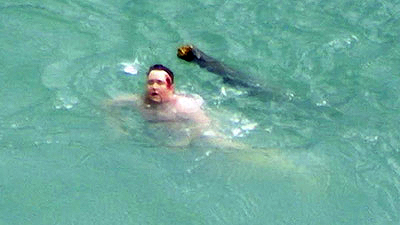
A 30 year old man from
London, Ontario jumped into Niagara Falls on Wednesday March 11th
2009 and survived the 170 foot (57m) plunge, then resisted
rescue attempts before he eventually was pulled from the icy
water to safety, police said.
The man, believed to be in
his late 30s, was semiconscious when he was taken to a hospital.
He lapsed into unconsciousness and was listed in critical
condition.
Niagara Parks Police Chief
Doug Kane said the man "voluntarily entered into the water and
refused medical assistance at the bottom."
He said the man was
suffering from hypothermia and a head injury. Police were unable
to get any information from the man because of the effects of
the near-freezing water.
A witness called police at
2:11 p.m. and told them a man had climbed over a retaining wall
and jumped into the rapids above the Horseshoe Falls. A short
time later, the man was seen near the base of the falls.
Specially trained falls
rescue crews tried to assist the man, but he swam away from them
toward the middle of the river.
Niagara Helicopter’s was
called in and got close enough to the victim so that wind from
its blades forced him close enough to shore for rescuers to
reach him. Hafen, 56, arrived in his Bell 407 helicopter 20
minutes after the man went in. He hovered his chopper just feet
above the water where the man continued to swim, his head
wounded from the fall. Mr. Hafen and his crew (made up of a
police officer and one of Mr. Hafen's colleagues) lowered a
harness to the man, who refused it.
"He wasn't cooperative,"
said pilot Ruedi Hafen, owner of Niagara Falls Helicopters. "He
didn't try to be helpful. We had a sling on him and he got out
of it."
Mr. Hafen said. "He was
actually shouting at us to get away."
So, Mr. Hafen tried
another approach. With winds at 35 knots and waves swirling, he
used the force of his helicopter's rotor to create an artificial
current, pushing the man towards shore.
Rescue crews said the man
was in the water for about 45 minutes and spent much of that
time resisting attempts to help him.
Firefighter Todd Brunning
and another rescue worker swam about 60 yards from shore,
grabbed hold of him and hauled him in.
Brunning said the man was
floating on his back and got caught in an eddy, allowing
Brunning to swim up behind him and wrap his arms around his
chest.
"I was surprised he was
still conscious when we got to him," Brunning said. "I guess he
was lucky."
Brunning said the man was
responsive to verbal commands but unable to talk.
"He was on a suicide
mission, I assume," Hafen said. "I've never, in my career, seen
someone so tough, swimming between the ice."
Konstantine Shatalov was
snapping photos of Niagara Falls when he saw the man jump.
"He went in like he was
swimming," said Shatalov. "I didn't think it was real. I thought
I imagined it."
The man, who appeared to
be in his mid-30s, with a heavy build, fell 57 metres from atop
the Horseshoe Falls and plunged into the water below. His
clothes had been torn off by the time he was spotted – still
alive – about 300 metres downstream. The river’s temperature was
7C water just above freezing, and ice floes could be seen in the
area.
Oshawa resident Phil
Richmond, who was returning from a trip to Florida, was among
dozens of onlookers who noticed the man.
"It appeared he didn't
want to come into shore. I thought he was an idiot to be honest
with you," said Richmond. "It looked like he was swimming, like
he was one of those polar bear nuts who swims naked. I didn't
realize he'd gone over the Falls."
The man was hypothermic,
losing consciousness and bleeding from a severe gash across his
forehead by the time he was rescued by firefighters, against his
will, about 40 minutes later. But he was alive
Sgt. Chris Gallagher was
among the first of the Canadian emergency personnel to respond
to the 911 call received at 2:11 p.m. yesterday.
"I was able to get down to
the river's edge, within approximately 40 feet (12 metres) of
the male who was in the water," he said. "I could see that he
was conscious and I attempted verbal commands to get him to the
shoreline, but he refused to do so."
"Everything in the investigation so far leads us to believe he
did this of his own accord," Sgt. Gallagher said, although
police have not determined whether it was a stunt or a suicide
attempt. "We don't know what his mental state was at the time."
"I told
him to swim toward me," Sgt. Gallagher said, but the man refused
to co-operate and instead began swimming back out toward the
current.
In fact, said Gallagher,
the man let go of a log he had been holding on to and swam
further into the current. As emergency crews arrived on the
shores at the bottom of the falls, they saw the man swimming
through the water, which was only a few degrees above freezing.
They called for him to come to shore, extending poles for him to
grab, but the man swam away.
The Niagara Falls Fire
Services' river rescue team was called in, while a police
officer boarded a private helicopter and flew to the scene.
Together, and despite the man's attempts to resist, they were
able to bring him ashore.
The helicopter blew the
man toward safe ground with the force of its rotor, where he was
snatched by a firefighter wearing a wetsuit and tethered to the
shore. The man was taken to Greater Niagara Hospital.
A Niagara Parks Police
investigation is ongoing. No charges have been laid. It is
illegal to attempt suicide by jumping into the Falls.
MR. Z
2012
(Survived - Failed
Suicide Attempt)
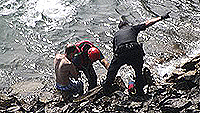
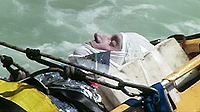
pictures courtesy Reuters
& Harry Rosettani
On a warm and sunny
morning of Monday May 21st 2012 at 10:20 a.m. -
Victoria Day holiday in Canada,
a man climbed over a retaining wall railing 20 to 30 feet (6-9m)
upriver of
the
Horseshoe
Falls and "deliberately jumped"
into
the
Niagara
River,
according to witness accounts given to Niagara Parks Police.
A man
plunged at least
170 foot (57m) over Niagara Falls and survived
— only the third person known to have gone over without a safety
device and live after a failed suicide attempt.
Niagara
Parks Police say witnesses reported seeing the man climb over a
railing at 10:20 a.m. Monday and “deliberately jump” into the
Niagara River above the Horseshoe Falls. He surfaced in the
lower Niagara River basin near the Journey behind the Falls
observation platform.
Seriously injured, he surfaced in the lower river basin near an
observation platform and managed to make it to shore on his own,
likely swept there by an eddy, said Platoon Chief Dan Orescanin
of the Niagara Falls, Ontario, Fire Department.
The
man, believed to be in his early 40s, was rescued about two
hours after he collapsed in waist-deep water near the rocky
shore. A waiting helicopter flew him to Hamilton General
Hospital for treatment of non- life-threatening injuries. Police
did not identify him.
Rescuers found him at the bottom of the Horseshoe Falls, on the
rocks near the Journey Behind the Falls. Firefighters used an
aerial truck to lift the man from the gorge to Table Rock
Complex.
"He waded ashore," said Platoon Chief Dan Orescanin of the
Niagara Falls, Ontario, Fire Department. "He must have gotten
swept into an eddy, floated over there and was able to get out
on his own.
The man, whose name wasn't released,
was conscious and talking at first but got quiet, Orescanin
said. He appeared to have chest injuries, including broken ribs
and a collapsed lung,
as well as a large wound on his forehead.
Parks Police Sergeant Chris Gallagher and firefighter Brandon
Fife treated the man at the water’s edge. The man was shirtless,
Gallagher but appeared to be wearing a pair of blue pants.
From there, about seven rescuers
struggled to haul a basket carrying the man back up the cliff to
a point where it could be lifted with ropes suspended from an
aerial truck. The entire rescue took about two hours.
"We had to basically hand carried him
back up, a foot at a time, up the rope," the chief said.
“The expectation is he will pull through,” said
Insp. Paul Forcier. “Things are looking positive for him.”
Forcier said Tuesday that police are treating the matter as a
mental health issue and an apparent suicide and because of that
would not be discussing it any further.
Police described the survivor as being middle-aged, but did not
release his name, or his hometown. Police typically don’t
release the names of people who have attempted suicide.
“We understand it’s certainly a story for the media, and in this
case a remarkable event,” said Forcier. “But there is a belief
in our industry with respect to nature or landmarks that could
attract suicidal behavior or other risks that the less publicity
given to it, the better.”
At Hamilton General Hospital,
spokeswoman Agnes Bongers said he was critically injured but
expected to survive.
Authorities don't believe the
plunge was a stunt.
Constantine Shatallof says he watched as the man jumped into the
rapids and then over the Horseshoe Falls.
Shatallof said, “Nobody seemed to notice or anything. So I was
thinking, did they see it? Or was it for real? So it took me ten
seconds and I called 911, and then other people ran from the top
and they saw the guy floating towards it so a lot of people saw
it.”
A sightseeing helicopter was immediately dispatched and a
harness was lowered, but the man refused to grab on. The chopper
then used its propellers to blow the man closer to the shore
line where rescuers could get a hold of him. Rescuers say even
after this man survived what they believe to be a suicide
attempt; he did nothing to make their job any easier.
“He was swimming first when we got there, pretty perky still,
and he could have helped up us getting the arm into the sling
but he was obstructive,” said Shatallof.
"Based on witness statements and
surveillance video, it doesn't appear in any way, shape, or form
that this was anything other than a suicide attempt," Niagara
Parks Police Sgt. Chris Gallagher.
The Niagara Falls Fire Department used
an aerial truck to lift the man from the gorge to a waiting Ornge air ambulance around 12:16 p.m.
Jennifer Kramer, spokesperson for Hamilton Health Sciences, said
the unidentified man who leapt into the water below the Falls on
Victoria Day weekend has improved, after he was previously
listed as critical.
Information was received that the man is married and has two
children.
NIK WALLENDA
2012
(Survived)

Nik Wallenda
born January 24, 1979 at Sarasota, Florida. He began performing
with his family at the age of two. He belongs to the seventh
generation of the Wallenda Family. He began walking wire at the
age 4. His first professional wire performance was at the age of
13.
The
Wallendas' zest for living life on the line has been passed down
from generation to generation - over 200 years. It all started
with great-grandfather, Karl Wallenda.
The Wallendas trace their
roots to 1780 Austria-Hungary, when ancestors traveled as a band
of acrobats, aerialists, jugglers, animal trainers and trapeze
artists.
On Friday
June 15th 2012 Nik Wallenda wire-walked across the Niagara River
Gorge at the Horseshoe Falls. The walk began at 10:16 pm from
Terrapin Point in Niagara Falls, New York and ended at 10:41 pm.
at Table Rock in Niagara Falls, Ontario.
An estimated
125,000 spectators were witness to this historic feat.
Before he
stepped onto the cable, Wallenda told the American broadcaster
(ABC TV) that he was "extremely excited" to have a chance to
achieve his dream.
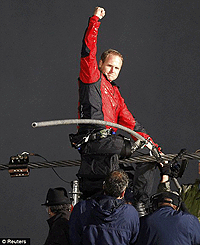
Wallenda
wearing a red and black outfit and hand-made leather shoes,
was wearing a safety tether during the crossing, which had been
the source of some controversy before the walk.
ABC
(American Broadcasting Company) that televised this event had
insisted that Wallenda wear a tether attached to the wire that
would prevent him from plunging to his death if he should lose
his balance. A C-shaped clamp trailed behind him on the walk,
designed to allow free passage over the pendulum anchors. If he
had slipped, he would dangle by his waist about eight feet below
the wire to wait for rescue.
Before the
walk, the 33-year-old said he was not happy about having to wear
a harness, and even expressed concern that the extra weight
could make his walk more difficult. Wallenda said he only agreed
because he was not willing to lose the chance and needed ABC's
sponsorship to help offset some of the $1.3million cost of the
spectacle.
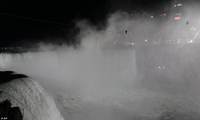
Nik's
mother, Delilah made the suede-leather shoes he uses because
they don't become slippery when wet, and in fact become stickier
with moisture.
Although the
weather conditions were good, mist swirled around him creating
some difficulties during some parts of the walk.
During the
walk he spoke to his father and ABC broadcasters using a
microphone. At the middle of the historic wire walk Nik Wallenda
expressed fatigue. Wallenda spoke to his father through a
headset and even took questions from ABC broadcasters as he made
his way across the specially installed cable, which was about
550 metres long and roughly five centimetres wide.
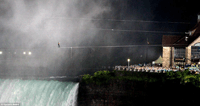
As he
reached close to the finishing line, he smiled, run and at last
was greeted by his wife and children and the cheering crowd.
The
daredevil was greeted on the Canadian side by two border agents,
who welcomed him to the country and inspected his passport.
"I'm not
carrying anything over, I promise," a tired but happy Wallenda
told the customs agents.
Wallenda
becomes the first wire-walker to cross the Niagara Gorge near
the base of the Falls.
After a
long wait and time-consuming negotiations, the Ontario Parks
Commission approved a one-time exemption in to allow Wallenda to
attempt a single crossing, reversing the 128-year ban on stunts.
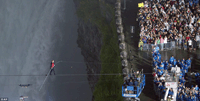
Niagara
Parks Commission chairwoman - Janice Thomson had said the
approval was a "unique one-time situation" and that Mr. Wallenda
was able to prove he had proper controls and safety measures in
place. She also said the commission would only consider requests
for such events from skilled professionals once every 20 years.
Wallenda is
married to his wife Erendira. They have three children: Yanni,
Amadaos and Evita. Wallenda and his wife own and operate
Wallendas Inc., a premier entertainment company based in
Florida.
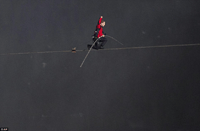
Nik cited
his great-grandfather Karl Wallenda as his primary inspiration
for the stunt. To quote him "My grandfather said, 'Life is being
on the wire; everything else is just waiting.' To me, I'm alive
when I'm on the wire."
Over the
past few days, the daredevil had been practising his craft and
overseeing the installation of the steel wire cable strung 60
metres above the churning waters.
Wallenda spent
months preparing for his historic stunt — getting permits,
raising funds and readying for the challenge posed by the
Niagara Falls crossing.
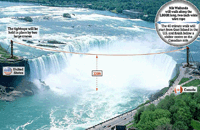
ERENDIRA WALLENDA
2020
(Survived)
Erendira Wallenda - age 36 is
part of a family known for their daredevil stunts. She is
married to Nik Wallenda.
On Thursday June 15th 2017, Erendira
Wallenda, a professional trapeze and aerial artist, gave a 20
minute acrobatic performance that included dangling by her teeth
over Niagara Falls near Terrapin Point.
During her performance from a
steel hoop dangling below the helicopter, Wallenda performed a
number of stunts , she hung by her teeth twice but she also
broke the world record for highest suspension over Niagara
Falls. She was tethered to a safety wire.
On the fifth anniversary of her
husband Nik Wallenda's walk over the Niagara River Gorge
(Horseshoe Falls) on a tight rope, Erendira performed from an
aerial hoop dangling approximately 300 feet above the thundering
water. Erendira and Nik have been married for 17 years.
Her act set a Guinness World
Record for height, breaking the record Nik set when he hung from
his teeth 250 feet above Silver Dollar City in Branson,
Missouri.
Transported by a helicopter,
Erendira sat in an aerial hoop and performed multiple acrobatic
flips before using only a mouth piece to suspend from the
circle. She then hung upside down with her feet on the hoop
before repeating the mouth stunt.
During her feat, her husband
leaned face-first out of the helicopter with headphones on that
allowed him to communicate with the pilot. She had a safety
harness around her waist to comply with New York State law for
stunts that occur more than 20 feet in the air.
After her routine, Erendira
waved to the crowd watching her with binoculars and cameras.
While she sat in the aerial hoop, the helicopter returned to the
roof of the garage of the Seneca Niagara Resort & Casino.
For 12,000
Years NIAGARA FALLS has been dominating
the Niagara Frontier.
IT IS AS ALLURING AND FEROCIOUS
AS IT IS BEAUTIFUL AND MAJESTIC. IT IS TRULY A MYSTIC MAGNET FOR THOSE PERSONS
WHO WISH TO CHALLENGE THEMSELVES AND THE NIAGARA RIVER IN THE FACE OF DEATH.
The previous Niagara Falls - Daredevils
and their stories are examples of the history found in Niagara Falls.
To explore and read more about the life
and times of these Daredevils, we would recommend your local Library. The
Niagara Falls Library in Niagara Falls has a wealth of information about the
daredevils and many others in their Special Collections Section.